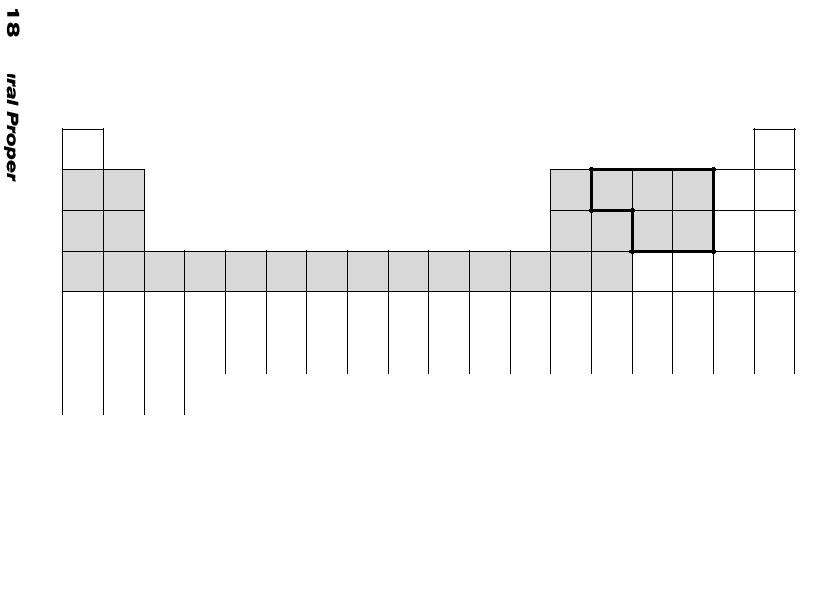
- •TABLE OF CONTENTS
- •CHAPTER 1 Structure of Materials
- •CHAPTER 2 Composition of Materials
- •CHAPTER 3 Phase Diagram Sources
- •Compressive Strength
- •Yield Strength
- •Shear Strength
- •Hardness
- •Abrasion Resistance
- •Fracture Toughness
- •Tensile Modulus
- •Young’s Modulus
- •Elastic Modulus
- •Compression Modulus
- •Bulk Modulus
- •Torsion Modulus
- •Modulus of Rupture
- •Elongation
- •Area Reduction
- •Viscosity
- •Dissipation Factor
- •Dielectric Strength
- •Tangent Loss
- •Density
- •Heat of Fusion
- •Thermal Conductivity
- •Thermal Expansion
- •Compressive Strength
- •Yield Strength
- •Flexural Strength
- •Friction
- •Abrasion Resistance
- •Poisson’s Ratio
- •Elongation
- •Area Reduction
- •Dissipation Factor
- •Tangent Loss
- •Permittivity
- •Arc Resistance
- •Flammability

CHAPTER 1 Structure of Materials
List of Tables |
Subatomic Structure |
|
Electronic Structure of Selected Elements |
|
Available Stable Isotopes of the Elements |
|
Atomic Structure |
|
Periodic Table of the Elements |
|
Periodic Table of Elements in Metallic Materials |
|
Periodic Table of Elements in Ceramic Materials |
|
Periodic Table of Elements in Polymeric Materials |
|
Periodic Table of Elements in Semiconducting Materials |
|
Periodic Table of Elements in Superconducting Metals |
|
Bond Structure |
|
Atomic and Ionic Radii of the Elements |
|
Bond Length Values Between Elements |
|
Periodic Table of Carbon Bond Lengths (Å) |
|
Carbon Bond Lengths |
|
Carbon Bond Lengths in Polymers |
|
Bond Angle Values Between Elements |
|
Crystal Structure |
|
Key to Tables of Crystal Structure of the Elements |
|
The Seven Crystal Systems |
©2001 CRC Press LLC
List of Tables
(Continued)
The Fourteen Bravais Lattices
Periodic Table of the Body Centered Cubic Elements Periodic Table of the Face Centered Cubic Elements Periodic Table of the Hexagonal Close Packed Elements Periodic Table of the Hexagonal Elements
Structure of Ceramics
Density
Atomic Mass of Selected Elements
Solid Density of Selected Elements
Density of Iron and Iron Alloys
Density of Wrought Stainless Steels
Density of Stainless Steels and Heat-Resistant Alloys Density of Aluminum Alloys
Density of Copper and Copper Alloys Density of Magnesium and Magnesium Alloys Density of Nickel and Nickel Alloys
Density of Lead and Lead Alloys
Density of Tin and Tin Alloys
Density of Wrought Titanium Alloys
Density of Titanium and Titanium alloys
Density of Zinc and Zinc Alloys
Density of Permanent Magnet Materials
Density of Precious Metals
Density of Superalloys
Density of Selected Ceramics
Density of Glasses
Specific Gravity of Polymers
Density of 55MSI Graphite/6061 Aluminum Composites Density of Graphite Fiber Reinforced Metals
Density of Si3N4 Composites
©2001 CRC Press LLC
Table 1. ELECTRONIC STRUCTURE OF SELECTED ELEMENTS
At. |
Element |
Sym |
|
|
|
|
|
|
Electronic Configuration |
|
|
|
|
|
|
|||||
No. |
|
|
1s |
2s |
2p |
3s |
3p |
3d |
4s |
4p |
4d |
4f |
5s |
5p |
5d |
5f |
6s |
6p |
6d |
7s |
|
|
|
||||||||||||||||||
1 |
Hydrogen |
H |
1 |
|
|
|
|
|
|
|
|
|
|
|
|
|
|
|
|
|
2 |
Helium |
He |
2 |
|
|
|
|
|
|
|
|
|
|
|
|
|
|
|
|
|
3 |
Lithium |
Li |
. |
1 |
|
|
|
|
|
|
|
|
|
|
|
|
|
|
|
|
4 |
Beryllium |
Be |
. |
2 |
|
|
|
|
|
|
|
|
|
|
|
|
|
|
|
|
5 |
Boron |
B |
. |
2 |
1 |
|
|
|
|
|
|
|
|
|
|
|
|
|
|
|
6 |
Carbon |
C |
. |
2 |
2 |
|
|
|
|
|
|
|
|
|
|
|
|
|
|
|
7 |
Nitrogen |
N |
. |
2 |
3 |
|
|
|
|
|
|
|
|
|
|
|
|
|
|
|
8 |
Oxygen |
O |
. |
2 |
4 |
|
|
|
|
|
|
|
|
|
|
|
|
|
|
|
9 |
Fluorine |
F |
. |
2 |
5 |
|
|
|
|
|
|
|
|
|
|
|
|
|
|
|
10 |
Neon |
N |
. |
2 |
6 |
|
|
|
|
|
|
|
|
|
|
|
|
|
|
|
11 |
Sodium |
Na |
. |
. |
. |
1 |
|
|
|
|
|
|
|
|
|
|
|
|
|
|
12 |
Magnesium |
Mg |
. |
. |
. |
2 |
|
|
|
|
|
|
|
|
|
|
|
|
|
|
13 |
Aluminum |
Al |
. |
. |
. |
2 |
1 |
|
|
|
|
|
|
|
|
|
|
|
|
|
14 |
Silicon |
Si |
. |
. |
. |
2 |
2 |
|
|
|
|
|
|
|
|
|
|
|
|
|
15 |
Phosphorus |
P |
. |
. |
. |
2 |
3 |
|
|
|
|
|
|
|
|
|
|
|
|
|
16 |
Sulfur |
S |
. |
. |
. |
2 |
4 |
|
|
|
|
|
|
|
|
|
|
|
|
|
17 |
Chlorine |
Cl |
. |
. |
. |
2 |
5 |
|
|
|
|
|
|
|
|
|
|
|
|
|
18 |
Argon |
Ar |
. |
. |
. |
2 |
6 |
|
|
|
|
|
|
|
|
|
|
|
|
|
19 |
Potassium |
K |
. |
. |
. |
. |
. |
|
1 |
|
|
|
|
|
|
|
|
|
|
|
20 |
Calcium |
Ca |
. |
. |
. |
. |
. |
|
2 |
|
|
|
|
|
|
|
|
|
|
|
21 |
Scandium |
Sc |
. |
. |
. |
. |
. |
1 |
2 |
|
|
|
|
|
|
|
|
|
|
|
22 |
Titanium |
Ti |
. |
. |
. |
. |
. |
2 |
2 |
|
|
|
|
|
|
|
|
|
|
|
23 |
Vanadium |
V |
. |
. |
. |
. |
. |
3 |
2 |
|
|
|
|
|
|
|
|
|
|
|
24 |
Chromium |
Cr |
. |
. |
. |
. |
. |
5 |
1 |
|
|
|
|
|
|
|
|
|
|
|
25 |
Manganese |
Mn |
. |
. |
. |
. |
. |
5 |
2 |
|
|
|
|
|
|
|
|
|
|
|
26 |
Iron |
Fe |
. |
. |
. |
. |
. |
6 |
2 |
|
|
|
|
|
|
|
|
|
|
|
27 |
Cobalt |
Co |
. |
. |
. |
. |
. |
7 |
2 |
|
|
|
|
|
|
|
|
|
|
|
28 |
Nickel |
Ni |
. |
. |
. |
. |
. |
8 |
2 |
|
|
|
|
|
|
|
|
|
|
|
29 |
Copper |
Cu |
. |
. |
. |
. |
. |
10 |
1 |
|
|
|
|
|
|
|
|
|
|
|
30 |
Zinc |
Zn |
. |
. |
. |
. |
. |
10 |
2 |
|
|
|
|
|
|
|
|
|
|
|
31 |
Gallium |
Ga |
. |
. |
. |
. |
. |
10 |
2 |
1 |
|
|
|
|
|
|
|
|
|
|
32 |
Germanium |
Ge |
. |
. |
. |
. |
. |
10 |
2 |
2 |
|
|
|
|
|
|
|
|
|
|
33 |
Arsenic |
As |
. |
. |
. |
. |
. |
10 |
2 |
3 |
|
|
|
|
|
|
|
|
|
|
34 |
Selenium |
Se |
. |
. |
. |
. |
. |
10 |
2 |
4 |
|
|
|
|
|
|
|
|
|
|
35 |
Bromine |
Br |
. |
. |
. |
. |
. |
10 |
2 |
5 |
|
|
|
|
|
|
|
|
|
|
36 |
Krypton |
Kr |
. |
. |
. |
. |
. |
10 |
2 |
6 |
|
|
|
|
|
|
|
|
|
|
37 |
Rubidium |
Rb |
. |
. |
. |
. |
. |
. |
. |
. |
|
|
1 |
|
|
|
|
|
|
|
38 |
Strontium |
Sr |
. |
. |
. |
. |
. |
. |
. |
. |
|
|
2 |
|
|
|
|
|
|
|
39 |
Yttrium |
Y |
. |
. |
. |
. |
. |
. |
. |
. |
1 |
|
2 |
|
|
|
|
|
|
|
40 |
Zirconium |
Zr |
. |
. |
. |
. |
. |
. |
. |
. |
2 |
|
2 |
|
|
|
|
|
|
|
41 |
Niobium |
Nb |
. |
. |
. |
. |
. |
. |
. |
. |
4 |
|
1 |
|
|
|
|
|
|
|
42 |
Molybdenum |
Mo |
. |
. |
. |
. |
. |
. |
. |
. |
5 |
|
1 |
|
|
|
|
|
|
|
43 |
Technetium |
Tc |
. |
. |
. |
. |
. |
. |
. |
. |
6 |
|
1 |
|
|
|
|
|
|
|
44 |
Ruthenium |
Ru |
. |
. |
. |
. |
. |
. |
. |
. |
7 |
|
1 |
|
|
|
|
|
|
|
45 |
Rhodium |
Rh |
. |
. |
. |
. |
. |
. |
. |
. |
8 |
|
1 |
|
|
|
|
|
|
|
46 |
Palladium |
Pd |
. |
. |
. |
. |
. |
. |
. |
. |
10 |
|
|
|
|
|
|
|
|
|
47 |
Silver |
Ag |
. |
. |
. |
. |
. |
. |
. |
. |
10 |
|
1 |
|
|
|
|
|
|
|
48 |
Cadmium |
Cd |
. |
. |
. |
. |
. |
. |
. |
. |
10 |
|
2 |
|
|
|
|
|
|
|
49 |
Indium |
In |
. |
. |
. |
. |
. |
. |
. |
. |
10 |
|
2 |
1 |
|
|
|
|
|
|
50 |
Tin |
Sn |
. |
. |
. |
. |
. |
. |
. |
. |
10 |
|
2 |
2 |
|
|
|
|
|
|
51 |
Antimony |
Sb |
. |
. |
. |
. |
. |
. |
. |
. |
10 |
|
2 |
3 |
|
|
|
|
|
|
52 |
Tellurium |
Te |
. |
. |
. |
. |
. |
. |
. |
. |
10 |
|
2 |
5 |
|
|
|
|
|
|
53 |
Iodine |
I |
. |
. |
. |
. |
. |
. |
. |
. |
10 |
|
2 |
5 |
|
|
|
|
|
|
54 |
Xenon |
Xe |
. |
. |
. |
. |
. |
. |
. |
. |
10 |
|
2 |
6 |
|
|
|
|
|
|
©2001 CRC Press LLC
At. |
Element |
Sym |
|
|
|
|
|
|
|
Electronic Configuration |
|
|
|
|
|
|
|||||
No. |
|
1s |
2s |
|
2p |
3s |
|
3p |
3d |
4s |
4p |
4d |
4f |
5s |
5p |
5d |
5f |
6s |
6p |
6d |
7s |
|
|
|
|
||||||||||||||||||
55 |
Cesium |
Ce |
. |
. |
. |
|
. |
. |
. |
. |
. |
. |
|
. |
. |
|
|
1 |
|
|
|
56 |
Barium |
Ba |
. |
. |
. |
|
. |
. |
. |
. |
. |
. |
|
. |
. |
|
|
2 |
|
|
|
57 |
Lantium |
La |
. |
. |
. |
|
. |
. |
. |
. |
. |
. |
|
. |
. |
1 |
|
2 |
|
|
|
58 |
Cerium |
Ce |
. |
. |
. |
|
. |
. |
. |
. |
. |
. |
2 |
. |
. |
|
|
2 |
|
|
|
59 |
Praseodymium |
Pr |
. |
. |
. |
|
. |
. |
. |
. |
. |
. |
3 |
. |
. |
|
|
2 |
|
|
|
60 |
Neodymium |
Nd |
. |
. |
. |
|
. |
. |
. |
. |
. |
. |
4 |
. |
. |
|
|
2 |
|
|
|
61 |
Promethium |
Pm |
. |
. |
. |
|
. |
. |
. |
. |
. |
. |
5 |
. |
. |
|
|
2 |
|
|
|
62 |
Samarium |
Sm |
. |
. |
. |
|
. |
. |
. |
. |
. |
. |
6 |
. |
. |
|
|
2 |
|
|
|
63 |
Europium |
Eu |
. |
. |
. |
|
. |
. |
. |
. |
. |
. |
7 |
. |
. |
|
|
2 |
|
|
|
64 |
Gadolinium |
Gd |
. |
. |
. |
|
. |
. |
. |
. |
. |
. |
7 |
. |
. |
1 |
|
2 |
|
|
|
65 |
Terbium |
Tb |
. |
. |
. |
|
. |
. |
. |
. |
. |
. |
9 |
. |
. |
|
|
2 |
|
|
|
66 |
Dysprosium |
Dy |
. |
. |
. |
|
. |
. |
. |
. |
. |
. |
10 |
. |
. |
|
|
2 |
|
|
|
67 |
Holmium |
Ho |
. |
. |
. |
|
. |
. |
. |
. |
. |
. |
11 |
. |
. |
|
|
2 |
|
|
|
68 |
Erbium |
Er |
. |
. |
. |
|
. |
. |
. |
. |
. |
. |
12 |
. |
. |
|
|
2 |
|
|
|
69 |
Thulium |
Tm |
. |
. |
. |
|
. |
. |
. |
. |
. |
. |
13 |
. |
. |
|
|
2 |
|
|
|
70 |
Ytterbium |
Yb |
. |
. |
. |
|
. |
. |
. |
. |
. |
. |
14 |
. |
. |
|
|
2 |
|
|
|
71 |
Lutetium |
Lu |
. |
. |
. |
|
. |
. |
. |
. |
. |
. |
14 |
. |
. |
1 |
|
2 |
|
|
|
72 |
Hafnium |
Hf |
. |
. |
. |
|
. |
. |
. |
. |
. |
. |
14 |
. |
. |
2 |
|
2 |
|
|
|
73 |
Tantalum |
Ta |
. |
. |
. |
|
. |
. |
. |
. |
. |
. |
14 |
. |
. |
3 |
|
2 |
|
|
|
74 |
Tungsten |
W |
. |
. |
. |
|
. |
. |
. |
. |
. |
. |
14 |
. |
. |
4 |
|
2 |
|
|
|
75 |
Rhenium |
Re |
. |
. |
. |
|
. |
. |
. |
. |
. |
. |
14 |
. |
. |
5 |
|
2 |
|
|
|
76 |
Osmium |
Os |
. |
. |
. |
|
. |
. |
. |
. |
. |
. |
14 |
. |
. |
6 |
|
2 |
|
|
|
77 |
Iridium |
Ir |
. |
. |
. |
|
. |
. |
. |
. |
. |
. |
14 |
. |
. |
9 |
|
|
|
|
|
78 |
Platinum |
Pt |
. |
. |
. |
|
. |
. |
. |
. |
. |
. |
14 |
. |
. |
9 |
|
1 |
|
|
|
79 |
Gold |
Au |
. |
. |
. |
|
. |
. |
. |
. |
. |
. |
14 |
. |
. |
10 |
|
1 |
|
|
|
80 |
Mercury |
Hg |
. |
. |
. |
|
. |
. |
. |
. |
. |
. |
14 |
. |
. |
10 |
|
2 |
|
|
|
81 |
Thallium |
Tl |
. |
. |
. |
|
. |
. |
. |
. |
. |
. |
14 |
. |
. |
10 |
|
2 |
1 |
|
|
82 |
Lead |
Pb |
. |
. |
. |
|
. |
. |
. |
. |
. |
. |
14 |
. |
. |
10 |
|
2 |
2 |
|
|
83 |
Bismuth |
Bi |
. |
. |
. |
|
. |
. |
. |
. |
. |
. |
14 |
. |
. |
10 |
|
2 |
3 |
|
|
84 |
Polonium |
Po |
. |
. |
. |
|
. |
. |
. |
. |
. |
. |
14 |
. |
. |
10 |
|
2 |
4 |
|
|
85 |
Asatine |
At |
. |
. |
. |
|
. |
. |
. |
. |
. |
. |
14 |
. |
. |
10 |
|
2 |
5 |
|
|
86 |
Radon |
Rn |
. |
. |
. |
|
. |
. |
. |
. |
. |
. |
14 |
. |
. |
10 |
|
2 |
6 |
|
|
87 |
Francium |
Fr |
. |
. |
. |
|
. |
. |
. |
. |
. |
. |
. |
. |
. |
. |
|
. |
. |
|
1 |
88 |
Radium |
Ra |
. |
. |
. |
|
. |
. |
. |
. |
. |
. |
. |
. |
. |
. |
|
. |
. |
|
2 |
89 |
Actinium |
Ac |
. |
. |
. |
|
. |
. |
. |
. |
. |
. |
. |
. |
. |
. |
|
. |
. |
1 |
2 |
90 |
Thorium |
Th |
. |
. |
. |
|
. |
. |
. |
. |
. |
. |
. |
. |
. |
. |
|
. |
. |
2 |
2 |
91 |
Protoactinium |
Pa |
. |
. |
. |
|
. |
. |
. |
. |
. |
. |
. |
. |
. |
. |
2 |
. |
. |
1 |
2 |
92 |
Uranium |
U |
. |
. |
. |
|
. |
. |
. |
. |
. |
. |
. |
. |
. |
. |
3 |
. |
. |
1 |
2 |
93 |
Neptunium |
Np |
. |
. |
. |
|
. |
. |
. |
. |
. |
. |
. |
. |
. |
. |
4 |
. |
. |
1 |
2 |
94 |
Plutonium |
Pu |
. |
. |
. |
|
. |
. |
. |
. |
. |
. |
. |
. |
. |
. |
6 |
. |
. |
|
2 |
95 |
Americium |
Am |
. |
. |
. |
|
. |
. |
. |
. |
. |
. |
. |
. |
. |
. |
7 |
. |
. |
|
2 |
96 |
Curium |
Cm |
. |
. |
. |
|
. |
. |
. |
. |
. |
. |
. |
. |
. |
. |
7 |
. |
. |
1 |
2 |
97 |
Berkelium |
Bk |
. |
. |
. |
|
. |
. |
. |
. |
. |
. |
. |
. |
. |
. |
9 |
. |
. |
|
2 |
98 |
Californium |
Cf |
. |
. |
. |
|
. |
. |
. |
. |
. |
. |
. |
. |
. |
. |
10 |
. |
. |
|
2 |
99 |
Einsteinium |
Es |
. |
. |
. |
|
. |
. |
. |
. |
. |
. |
. |
. |
. |
. |
11 |
. |
. |
|
2 |
100 |
Fermium |
Fm |
. |
. |
. |
|
. |
. |
. |
. |
. |
. |
. |
. |
. |
. |
12 |
. |
. |
|
2 |
101 |
Mendelevium |
Md |
. |
. |
. |
|
. |
. |
. |
. |
. |
. |
. |
. |
. |
. |
13 |
. |
. |
|
2 |
102 |
Nobelium |
No |
. |
. |
. |
|
. |
. |
. |
. |
. |
. |
. |
. |
. |
. |
14 |
. |
. |
|
2 |
103 |
Lawrencium |
Lw |
. |
. |
. |
|
. |
. |
. |
. |
. |
. |
. |
. |
. |
. |
14 |
. |
. |
1 |
2 |
©2001 CRC Press LLC

Table 2. AVAILABLE STABLE ISOTOPES OF THE ELEMENTS
(SHEET 1 OF 11)
|
|
Natural |
|
Mass |
Abundance |
Element |
No. |
(%) |
|
|
|
|
|
|
Hydrogen |
1 |
99.985 |
|
2 |
0.015 |
Helium |
3 |
0.00013 |
|
4 |
≈100.0 |
Lithium |
6 |
7.42 |
|
7 |
92.58 |
Beryllium |
9 |
100.0 |
Boron |
10 |
19.78 |
|
11 |
80.22 |
Carbon |
12 |
98.89 |
|
13 |
1.11 |
Nitrogen |
14 |
99.63 |
|
15 |
0.37 |
Oxygen |
16 |
99.76 |
|
17 |
0.04 |
|
18 |
0.20 |
Fluorine |
19 |
100.0 |
Neon |
20 |
90.92 |
|
21 |
0.26 |
|
22 |
8.82 |
Sodium |
23 |
100.0 |
Magnesium |
24 |
78.70 |
|
25 |
10.13 |
|
26 |
11.17 |
|
|
|
Source: Wang, Y., Ed., Handbook of Radioactive Nuclides, The Chemical Rubber Co., Cleveland, 1969, 25.
©2001 CRC Press LLC

Table 2. AVAILABLE STABLE ISOTOPES OF THE ELEMENTS
(SHEET 2 OF 11)
|
|
Natural |
|
Mass |
Abundance |
Element |
No. |
(%) |
|
|
|
|
|
|
Aluminum |
27 |
100.0 |
Silicon |
28 |
92.21 |
|
29 |
4.70 |
|
30 |
3.09 |
Phosphorus |
31 |
100.0 |
Sulfur |
32 |
95.0 |
|
33 |
0.76 |
|
34 |
4.22 |
|
36 |
0.014 |
Chlorine |
35 |
75.53 |
|
37 |
24.47 |
Argon |
36 |
0.34 |
|
38 |
0.06 |
|
40 |
99.60 |
Potassium |
39 |
93.1 |
|
40a |
0.01 |
|
41 |
6.9 |
Calcium |
40 |
96.97 |
|
42 |
0.64 |
|
43 |
0.14 |
|
44 |
2.06 |
|
46 |
0.003 |
|
48 |
0.18 |
Scandium |
45 |
100.0 |
|
|
|
Source: Wang, Y., Ed., Handbook of Radioactive Nuclides, The Chemical Rubber Co., Cleveland, 1969, 25.
©2001 CRC Press LLC

Table 2. AVAILABLE STABLE ISOTOPES OF THE ELEMENTS
(SHEET 3 OF 11)
|
|
Natural |
|
Mass |
Abundance |
Element |
No. |
(%) |
|
|
|
|
|
|
Titanium |
46 |
7.93 |
|
47 |
7.28 |
|
48 |
73.94 |
|
49 |
5.51 |
|
50 |
5.34 |
Vanadium |
50 |
0.24 |
|
51 |
99.76 |
Chromium |
50 |
4.31 |
|
52 |
83.76 |
|
53 |
9.55 |
|
54 |
2.38 |
Manganese |
55 |
100.0 |
Iron |
54 |
5.82 |
|
56 |
91.66 |
|
57 |
2.19 |
|
58 |
0.33 |
Cobalt |
59 |
100.0 |
Nickel |
58 |
67.84 |
|
60 |
26.23 |
|
61 |
1.19 |
|
62 |
3.66 |
|
64 |
1.08 |
Copper |
63 |
69.09 |
|
65 |
30.91 |
|
|
|
Source: Wang, Y., Ed., Handbook of Radioactive Nuclides, The Chemical Rubber Co., Cleveland, 1969, 25.
©2001 CRC Press LLC

Table 2. AVAILABLE STABLE ISOTOPES OF THE ELEMENTS
(SHEET 4 OF 11)
|
|
Natural |
|
Mass |
Abundance |
Element |
No. |
(%) |
|
|
|
|
|
|
Zinc |
64 |
48.89 |
|
66 |
27.81 |
|
67 |
4.11 |
|
68 |
18.57 |
|
70 |
0.62 |
Gallium |
69 |
60.4 |
|
71 |
39.6 |
Germanium |
70 |
20.52 |
|
72 |
27.43 |
|
73 |
7.76 |
|
74 |
36.54 |
|
76 |
7.76 |
Arsenic |
75 |
100.0 |
Selenium |
74 |
0.87 |
|
76 |
9.02 |
|
77 |
7.58 |
|
78 |
23.52 |
|
80 |
49.82 |
|
82 |
9.19 |
Bromine |
79 |
50.54 |
|
81 |
49.46 |
Krypton |
78 |
0.35 |
|
80 |
2.27 |
|
82 |
11.56 |
|
83 |
11.55 |
|
84 |
56.90 |
|
86 |
17.37 |
Rubidium |
85 |
72.15 |
|
87 |
27.85 |
|
|
|
Source: Wang, Y., Ed., Handbook of Radioactive Nuclides, The Chemical Rubber Co., Cleveland, 1969, 25.
©2001 CRC Press LLC

Table 2. AVAILABLE STABLE ISOTOPES OF THE ELEMENTS
(SHEET 5 OF 11)
|
|
Natural |
|
Mass |
Abundance |
Element |
No. |
(%) |
|
|
|
|
|
|
Strontium |
84 |
0.56 |
|
86 |
9.86 |
|
87 |
7.02 |
|
88 |
82.56 |
Yttrium |
89 |
100.0 |
Zirconium |
90 |
51.46 |
|
91 |
11.23 |
|
92 |
17.11 |
|
94 |
17.40 |
|
96 |
2.80 |
Niobium |
93 |
100.0 |
Molybdenum |
92 |
15.84 |
|
94 |
9.04 |
|
95 |
15.72 |
|
96 |
16.53 |
|
97 |
9.46 |
|
98 |
23.78 |
|
100 |
9.63 |
Ruthenium |
96 |
5.51 |
|
98 |
1.87 |
|
99 |
12.72 |
|
100 |
12.62 |
|
101 |
17.07 |
|
102 |
31.61 |
|
104 |
18.60 |
Rhodium |
103 |
100.0 |
|
|
|
Source: Wang, Y., Ed., Handbook of Radioactive Nuclides, The Chemical Rubber Co., Cleveland, 1969, 25.
©2001 CRC Press LLC

Table 2. AVAILABLE STABLE ISOTOPES OF THE ELEMENTS
(SHEET 6 OF 11)
|
|
Natural |
|
Mass |
Abundance |
Element |
No. |
(%) |
|
|
|
|
|
|
Palladium |
102 |
0.96 |
|
104 |
10.97 |
|
105 |
22.23 |
|
106 |
27.33 |
|
108 |
26.71 |
|
110 |
11.81 |
Silver |
107 |
51.82 |
|
109 |
48.18 |
Cadmium |
106 |
1.22 |
|
108 |
0.88 |
|
110 |
12.39 |
|
111 |
12.75 |
|
112 |
24.07 |
|
113 |
12.26 |
|
114 |
28.86 |
|
116 |
7.58 |
Indium |
113 |
4.28 |
|
115 |
95.72 |
Tin |
112 |
0.96 |
|
114 |
0.66 |
|
115 |
0.35 |
|
116 |
14.30 |
|
117 |
7.61 |
|
118 |
24.03 |
|
119 |
8.58 |
|
120 |
32.85 |
|
122 |
4.72 |
|
124 |
5.94 |
Antimony |
121 |
57.25 |
|
123 |
42.75 |
|
|
|
Source: Wang, Y., Ed., Handbook of Radioactive Nuclides, The Chemical Rubber Co., Cleveland, 1969, 25.
©2001 CRC Press LLC

Table 2. AVAILABLE STABLE ISOTOPES OF THE ELEMENTS
(SHEET 7 OF 11)
|
|
Natural |
|
Mass |
Abundance |
Element |
No. |
(%) |
|
|
|
|
|
|
Tellurium |
120 |
0.09 |
|
122 |
2.46 |
|
123 |
0.87 |
|
124 |
4.61 |
|
125 |
6.99 |
|
126 |
18.71 |
|
128 |
31.79 |
|
130 |
34.48 |
Iodine |
127 |
100.0 |
Xenon |
124 |
0.096 |
|
126 |
0.090 |
|
128 |
1.92 |
|
129 |
26.44 |
|
130 |
4.08 |
|
131 |
21.18 |
|
132 |
26.89 |
|
134 |
10.44 |
|
136 |
8.87 |
Cesium |
133 |
100.0 |
Barium |
130 |
0.101 |
|
132 |
0.097 |
|
134 |
2.42 |
|
135 |
6.59 |
|
136 |
7.81 |
|
137 |
11.30 |
|
138 |
71.66 |
Lanthanum |
138 |
0.09 |
|
139 |
99.91 |
|
|
|
Source: Wang, Y., Ed., Handbook of Radioactive Nuclides, The Chemical Rubber Co., Cleveland, 1969, 25.
©2001 CRC Press LLC

Table 2. AVAILABLE STABLE ISOTOPES OF THE ELEMENTS
(SHEET 8 OF 11)
|
|
Natural |
|
Mass |
Abundance |
Element |
No. |
(%) |
|
|
|
|
|
|
Cerium |
136 |
0.193 |
|
138 |
0.250 |
|
140 |
88.48 |
|
142d |
11.07 |
Praseodymium |
|
|
|
141 |
100.0 |
Neodymium |
142 |
27.11 |
|
143 |
12.17 |
|
144 |
23.85 |
|
146 |
17.22 |
|
148 |
5.73 |
|
150 |
5.62 |
Samarium |
144 |
3.09 |
|
147e |
14.97 |
|
148f |
11.24 |
|
149g |
13.83 |
|
150 |
7.44 |
|
152 |
26.72 |
|
154 |
22.71 |
Europium |
151 |
47.82 |
|
153 |
52.18 |
Gadolinium |
152h |
0.20 |
|
154 |
2.15 |
|
155 |
14.73 |
|
156 |
20.47 |
|
157 |
15.68 |
|
158 |
24.87 |
|
160 |
21.90 |
Terbium |
159 |
100.0 |
|
|
|
Source: Wang, Y., Ed., Handbook of Radioactive Nuclides, The Chemical Rubber Co., Cleveland, 1969, 25.
©2001 CRC Press LLC

Table 2. AVAILABLE STABLE ISOTOPES OF THE ELEMENTS
(SHEET 9 OF 11)
|
|
Natural |
|
Mass |
Abundance |
Element |
No. |
(%) |
|
|
|
|
|
|
Dysprosium |
156i |
0.052 |
|
158 |
0.090 |
|
160 |
2.29 |
|
161 |
18.88 |
|
162 |
25.53 |
|
163 |
24.97 |
|
164 |
28.18 |
Holmium |
165 |
100.0 |
|
186 |
28.41 |
Erbium |
162 |
0.136 |
|
164 |
1.56 |
|
166 |
33.41 |
|
167 |
22.94 |
|
168 |
27.07 |
|
170 |
14.88 |
|
186 |
1.59 |
Thulium |
169 |
100.0 |
|
189 |
16.1 |
Ytterbium |
168 |
0.135 |
|
170 |
3.03 |
|
171 |
14.31 |
|
172 |
21.82 |
|
173 |
16.13 |
|
174 |
31.84 |
|
176 |
12.73 |
Lutetium |
175 |
97.40 |
|
176j |
2.60 |
|
|
|
Source: Wang, Y., Ed., Handbook of Radioactive Nuclides, The Chemical Rubber Co., Cleveland, 1969, 25.
©2001 CRC Press LLC

Table 2. AVAILABLE STABLE ISOTOPES OF THE ELEMENTS
(SHEET 10 OF 11)
|
|
Natural |
|
Mass |
Abundance |
Element |
No. |
(%) |
|
|
|
|
|
|
Haffiium |
174k |
0.18 |
|
176 |
5.20 |
|
177 |
18.50 |
|
178 |
27.14 |
|
179 |
13.75 |
|
180 |
35.24 |
Tantalum |
180 |
0.012 |
|
181 |
99.988 |
Tungsten |
180 |
0.14 |
|
182 |
26.41 |
|
183 |
14.40 |
|
184 |
30.64 |
Rhenium |
185 |
37.07 |
|
187 |
62.93 |
Osmium |
184 |
0.018 |
|
187 |
1.64 |
|
188 |
13.3 |
|
190 |
26.4 |
|
192 |
41.0 |
Iridium |
191 |
37.3 |
|
193 |
62.7 |
Platinum |
190m |
0.013 |
|
192 |
0.78 |
|
194 |
32.9 |
|
195 |
33.8 |
|
196 |
25.3 |
|
198 |
7.2 |
Gold |
197 |
100.0 |
|
|
|
Source: Wang, Y., Ed., Handbook of Radioactive Nuclides, The Chemical Rubber Co., Cleveland, 1969, 25.
©2001 CRC Press LLC

Table 2. AVAILABLE STABLE ISOTOPES OF THE ELEMENTS
(SHEET 11 OF 11)
|
|
Natural |
|
Mass |
Abundance |
Element |
No. |
(%) |
|
|
|
|
|
|
Mercury |
196 |
0.146 |
|
198 |
10.02 |
|
199 |
16.84 |
|
200 |
23.13 |
|
201 |
13.22 |
|
202 |
29.80 |
|
204 |
6.85 |
Thallium |
203 |
29.50 |
|
205 |
70.50 |
Lead |
204 |
1.48 |
|
206 |
23.6 |
|
207 |
22.6 |
|
208 |
52.3 |
Bismuth |
209 |
100.0 |
Thorium |
232n† |
100.0 |
Uranium |
234o† |
0.0006 |
|
235p† |
0.72 |
|
238q† |
99.27 |
|
|
|
Source: Wang, Y., Ed., Handbook of Radioactive Nuclides, The Chemical Rubber Co., Cleveland, 1969, 25.
ahalf-life = 1.3 x 109 y.
bhalf-life > 1015 y
chalf-life = 5 x 1014 y
dhalf-life = 5 x 1014 y
ehalf-life = 1.06 x 1011 y
fhalf-life = 1.2 x 1013 y
ghalf-life = 1.2 x 1014 y
hhalf-life = 1.1 x 1014 y
ihalf-life = 2 x 1014 y
jhalf-life = 2.2 x 1010 y
khalf-life = 4.3 x 1015 y
lhalf-life = 4 x 1010 y
mhalf-life = 6 x 1011 y
nhalf-life = 1.4 x 1010 y
ohalf-life = 2.5 x 105 y
phalf-life = 7.1 x 108 y
qhalf-life = 4.5 x 109 y
†naturally occurring.
©2001 CRC Press LLC

Table 3. PERIODIC TABLE OF THE ELEMENTS
1 |
2 |
3 |
4 |
5 |
6 |
7 |
8 |
9 |
10 |
11 |
12 |
13 |
14 |
15 |
16 |
17 |
18 |
IA |
|
|
|
|
|
|
|
|
|
|
|
|
|
|
|
|
VIIA |
|
|
|
|
|
|
|
|
|
|
|
|
|
|
|
|
|
|
1 |
|
|
|
|
|
|
|
|
|
|
|
|
|
|
|
|
2 |
H |
IIA |
|
|
|
|
|
|
|
|
|
|
IIIA |
IVA |
VA |
VIA |
VIIA |
He |
|
|
|
|
|
|
|
|
|
|
|
|
||||||
|
|
|
|
|
|
|
|
|
|
|
|
|
|
|
|
|
|
3 |
4 |
|
|
|
|
|
|
|
|
|
|
5 |
6 |
7 |
8 |
9 |
10 |
Li |
Be |
|
|
|
|
|
|
|
|
|
|
B |
C |
N |
O |
F |
Ne |
|
|
|
|
|
|
|
|
|
|
|
|
|
|
|
|
|
|
11 |
12 |
|
|
|
|
|
|
|
|
|
|
13 |
14 |
15 |
16 |
17 |
18 |
Na |
Mg |
IIIB |
IVB |
VB |
VIB |
VIIB |
----- |
VIII |
----- |
IB |
IIB |
Al |
Si |
P |
S |
Cl |
Ar |
|
|
|
|
|
|
|
|
|
|
|
|
|
|
|
|
|
|
19 |
20 |
21 |
22 |
23 |
24 |
25 |
26 |
27 |
28 |
29 |
30 |
31 |
32 |
33 |
34 |
35 |
36 |
K |
Ca |
Sc |
Ti |
V |
Cr |
Mn |
Fe |
Co |
Ni |
Cu |
Zn |
Ga |
Ge |
As |
Se |
Br |
Kr |
|
|
|
|
|
|
|
|
|
|
|
|
|
|
|
|
|
|
37 |
38 |
39 |
40 |
41 |
42 |
43 |
44 |
45 |
46 |
47 |
48 |
49 |
50 |
51 |
52 |
53 |
54 |
Rb |
Sr |
Y |
Zr |
Nb |
Mo |
Tc |
Ru |
Rh |
Pd |
Ag |
Cd |
In |
Sn |
Sb |
Te |
I |
Xe |
|
|
|
|
|
|
|
|
|
|
|
|
|
|
|
|
|
|
55 |
56 |
|
72 |
73 |
74 |
75 |
76 |
77 |
78 |
79 |
80 |
81 |
82 |
83 |
84 |
85 |
86 |
Cs |
Ba |
|
Hf |
Ta |
W |
Re |
Os |
Ir |
Pt |
Au |
Hg |
Tl |
Pb |
Bi |
Po |
At |
Rn |
|
|
|
|
|
|
|
|
|
|
|
|
|
|
|
|
|
|
87 |
88 |
|
|
|
|
|
|
|
|
|
|
|
|
|
|
|
|
Fr |
Ra |
|
|
|
|
|
|
|
|
|
|
|
|
|
|
|
|
|
|
|
|
|
|
|
|
|
|
|
|
|
|
|
|
|
|
|
|
|
|
|
|
|
|
|
|
|
|
|
|
|
|
|
|
|
57 |
58 |
59 |
60 |
61 |
62 |
63 |
64 |
65 |
66 |
67 |
68 |
69 |
70 |
71 |
|
|
|
La |
Ce |
Pr |
Nd |
Pm |
Sm |
Eu |
Gd |
Tb |
Dy |
Ho |
Er |
Tm |
Yb |
Lu |
|
|
|
|
|
|
|
|
|
|
|
|
|
|
|
|
|
|
|
|
|
89 |
90 |
91 |
92 |
93 |
94 |
95 |
96 |
97 |
98 |
99 |
100 |
101 |
102 |
103 |
|
|
|
Ac |
Th |
Pa |
U |
Np |
Pu |
Am |
Cm |
Bk |
Cf |
Es |
Fm |
Md |
No |
Lw |
|
|
|
|
|
|
|
|
|
|
|
|
|
|
|
|
|
|
|
|
©2001 CRC Press LLC

Table 4. PERIODIC TABLE OF ELEMENTS IN METALLIC MATERIALS
1 |
2 |
3 |
4 |
5 |
6 |
7 |
8 |
9 |
10 |
11 |
12 |
13 |
14 |
15 |
16 |
17 |
18 |
IA |
|
|
|
|
|
|
|
|
|
|
|
|
|
|
|
|
VIIA |
|
IIA |
|
|
|
|
|
|
|
|
|
|
IIIA |
IVA |
VA |
VIA |
VIIA |
|
|
|
|
|
|
|
|
|
|
|
|
|
||||||
|
|
|
|
|
|
|
|
|
|
|
|
|
|
|
|
|
|
3 |
4 |
|
|
|
|
|
|
|
|
|
|
5 |
|
|
|
|
|
Li |
Be |
|
|
|
|
|
|
|
|
|
|
B |
|
|
|
|
|
|
|
|
|
|
|
|
|
|
|
|
|
|
|
|
|
|
|
11 |
12 |
|
|
|
|
|
|
|
|
|
|
13 |
|
|
|
|
|
Na |
Mg |
IIIB |
IVB |
VB |
VIB |
VIIB |
----- |
VIII |
----- |
IB |
IIB |
Al |
|
|
|
|
|
|
|
|
|
|
|
|
|
|
|
|
|
|
|
|
|
|
|
19 |
20 |
21 |
22 |
23 |
24 |
25 |
26 |
27 |
28 |
29 |
30 |
31 |
|
|
|
|
|
K |
Ca |
Sc |
Ti |
V |
Cr |
Mn |
Fe |
Co |
Ni |
Cu |
Zn |
Ga |
|
|
|
|
|
|
|
|
|
|
|
|
|
|
|
|
|
|
|
|
|
|
|
37 |
38 |
39 |
40 |
41 |
42 |
43 |
44 |
45 |
46 |
47 |
48 |
49 |
50 |
51 |
|
|
|
Rb |
Sr |
Y |
Zr |
Nb |
Mo |
Tc |
Ru |
Rh |
Pd |
Ag |
Cd |
In |
Sn |
Sb |
|
|
|
|
|
|
|
|
|
|
|
|
|
|
|
|
|
|
|
|
|
55 |
56 |
|
72 |
73 |
74 |
75 |
76 |
77 |
78 |
79 |
80 |
81 |
82 |
83 |
|
|
|
Cs |
Ba |
|
Hf |
Ta |
W |
Re |
Os |
Ir |
Pt |
Au |
Hg |
Tl |
Pb |
Bi |
|
|
|
|
|
|
|
|
|
|
|
|
|
|
|
|
|
|
|
|
|
87 |
88 |
|
|
|
|
|
|
|
|
|
|
|
|
|
|
|
|
Fr |
Ra |
|
|
|
|
|
|
|
|
|
|
|
|
|
|
|
|
|
|
|
|
|
|
|
|
|
|
|
|
|
|
|
|
|
|
|
|
|
|
|
|
|
|
|
|
|
|
|
|
|
|
|
|
|
57 |
58 |
59 |
60 |
61 |
62 |
63 |
64 |
65 |
66 |
67 |
68 |
69 |
70 |
71 |
|
|
|
La |
Ce |
Pr |
Nd |
Pm |
Sm |
Eu |
Gd |
Tb |
Dy |
Ho |
Er |
Tm |
Yb |
Lu |
|
|
|
|
|
|
|
|
|
|
|
|
|
|
|
|
|
|
|
|
|
89 |
90 |
91 |
92 |
93 |
94 |
95 |
96 |
97 |
98 |
99 |
100 |
101 |
102 |
103 |
|
|
|
Ac |
Th |
Pa |
U |
Np |
Pu |
Am |
Cm |
Bk |
Cf |
Es |
Fm |
Md |
No |
Lw |
|
|
|
|
|
|
|
|
|
|
|
|
|
|
|
|
|
|
|
|
©2001 CRC Press LLC

Table 5. PERIODIC TABLE OF ELEMENTS IN CERAMIC MATERIALS
1 |
2 |
3 |
4 |
5 |
6 |
7 |
8 |
9 |
10 |
11 |
12 |
13 |
14 |
15 |
16 |
17 |
18 |
IA |
|
|
|
|
|
|
|
|
|
|
|
|
|
|
|
|
VIIA |
|
IIA |
|
|
|
|
|
|
|
|
|
|
IIIA |
IVA |
VA |
VIA |
VIIA |
3 |
4 |
|
|
|
|
|
|
|
|
|
|
5 |
6 |
7 |
8 |
|
Li |
Be |
|
|
|
|
|
|
|
|
|
|
B |
C |
N |
O |
|
11 |
12 |
|
|
|
|
|
|
|
|
|
|
13 |
14 |
15 |
16 |
|
Na |
Mg |
IIIB |
IVB |
VB |
VIB |
VIIB |
----- |
VIII |
----- |
IB |
IIB |
Al |
Si |
P |
S |
|
19 |
20 |
21 |
22 |
23 |
24 |
25 |
26 |
27 |
28 |
29 |
30 |
31 |
32 |
|
|
|
K |
Ca |
Sc |
Ti |
V |
Cr |
Mn |
Fe |
Co |
Ni |
Cu |
Zn |
Ga |
Ge |
|
|
|
37 |
|
38 |
|
39 |
|
40 |
|
41 |
|
42 |
|
43 |
|
44 |
|
45 |
|
46 |
|
47 |
|
48 |
|
49 |
|
50 |
|
51 |
|
|
Rb |
|
Sr |
|
Y |
|
Zr |
|
Nb |
|
Mo |
|
Tc |
|
Ru |
|
Rh |
|
Pd |
|
Ag |
|
Cd |
|
In |
|
Sn |
|
Sb |
|
|
|
|
|
|
|
|
|
|
|
|
|
|
|
|
|
|
|
|
|
|
|
|
|
|
|
|
|
|
|
|
|
55 |
|
56 |
|
|
|
72 |
|
73 |
|
74 |
|
75 |
|
76 |
|
77 |
|
78 |
|
79 |
|
80 |
|
81 |
|
82 |
|
83 |
|
|
Cs |
|
Ba |
|
|
|
Hf |
|
Ta |
|
W |
|
Re |
|
Os |
|
Ir |
|
Pt |
|
Au |
|
Hg |
|
Tl |
|
Pb |
|
Bi |
|
|
|
|
|
|
|
|
|
|
|
|
|
|
|
|
|
|
|
|
|
|
|
|
|
|
|
|
|
|
|
|
|
87 |
|
88 |
|
|
|
|
|
|
|
|
|
|
|
|
|
|
|
|
|
|
|
|
|
|
|
|
|
|
|
|
Fr |
|
Ra |
|
|
|
|
|
|
|
|
|
|
|
|
|
|
|
|
|
|
|
|
|
|
|
|
|
|
|
|
|
|
|
|
|
|
|
|
|
|
|
|
|
|
|
|
|
|
|||||||||||||
|
|
|
|
|
|
|
|
|
|
|
|
|
|
|
|
|
|
|
|
|
|
|
|
|
|
|
|
|
|
|
|
|
57 |
|
58 |
|
59 |
|
60 |
|
61 |
|
62 |
|
63 |
|
64 |
|
65 |
|
66 |
|
67 |
|
68 |
|
69 |
|
70 |
71 |
|
|
|
La |
|
Ce |
|
Pr |
|
Nd |
|
Pm |
|
Sm |
|
Eu |
|
Gd |
|
Tb |
|
Dy |
|
Ho |
|
Er |
|
Tm |
|
Yb |
Lu |
|
|
|
|
|
|
|
|
|
|
|
|
|
|
|
|
|
|
|
|
|
|
|
|
|
|
|
|
|
|
|
|
|
|
89 |
|
90 |
|
91 |
|
92 |
|
93 |
|
94 |
|
95 |
|
96 |
|
97 |
|
98 |
|
99 |
|
100 |
|
101 |
|
102 |
103 |
|
|
|
Ac |
|
Th |
|
Pa |
|
U |
|
Np |
|
Pu |
|
Am |
|
Cm |
|
Bk |
|
Cf |
|
Es |
|
Fm |
|
Md |
|
No |
Lw |
|
|
|
|
|
|
|
|
|
|
|
|
|
|
|
|
|
|
|
|
|
|
|
|
|
|
|
|
|
|
|
|
©2001 CRC Press LLC

Table 6. PERIODIC TABLE OF ELEMENTS IN POLYMERIC MATERIALS
1 |
2 |
3 |
4 |
5 |
6 |
7 |
8 |
9 |
10 |
11 |
12 |
13 |
14 |
15 |
16 |
17 |
18 |
IA |
|
|
|
|
|
|
|
|
|
|
|
|
|
|
|
|
VIIA |
|
|
|
|
|
|
|
|
|
|
|
|
|
|
|
|
|
|
1 |
|
|
|
|
|
|
|
|
|
|
|
|
|
|
|
|
|
H |
IIA |
|
|
|
|
|
|
|
|
|
|
IIIA |
IVA |
VA |
VIA |
VIIA |
|
|
|
|
|
|
|
|
|
|
|
|
|
||||||
|
|
|
|
|
|
|
|
|
|
|
|
|
6 |
7 |
8 |
9 |
|
|
|
|
|
|
|
|
|
|
|
|
|
|
C |
N |
O |
F |
|
|
|
|
|
|
|
|
|
|
|
|
|
|
|
|
|
|
|
|
|
|
|
|
|
|
|
|
|
|
|
|
14 |
|
|
|
|
|
|
IIIB |
IVB |
VB |
VIB |
VIIB |
----- |
VIII |
----- |
IB |
IIB |
|
Si |
|
|
|
|
|
|
|
|
|
|
|
|
|
|
|
|
|
|
|
|
|
|
|
|
|
|
|
|
|
|
|
|
|
|
|
|
|
|
|
|
|
|
|
|
|
|
|
|
|
|
|
|
|
|
|
|
|
|
|
|
|
|
|
|
|
|
|
|
|
|
|
|
|
|
|
|
|
|
|
|
|
|
|
|
|
|
|
|
|
|
|
|
|
|
|
|
|
|
|
|
|
|
|
|
|
|
|
|
|
|
|
|
|
|
|
|
|
|
|
|
|
|
|
|
|
|
|
|
|
|
|
|
|
|
|
|
|
|
|
|
|
|
|
|
|
|
|
|
©2001 CRC Press LLC

Table 7. PERIODIC TABLE OF ELEMENTS IN SEMICONDUCTING MATERIALS
1 |
2 |
3 |
4 |
5 |
6 |
7 |
8 |
9 |
10 |
11 |
12 |
13 |
14 |
15 |
16 |
17 |
18 |
IA |
|
|
|
|
|
|
|
|
|
|
|
|
|
|
|
|
VIIA |
|
IIA |
|
|
|
|
|
|
|
|
|
|
IIIA |
IVA |
VA |
VIA |
VIIA |
|
|
|
|
|
|
|
|
|
|
|
|
|
||||||
|
|
|
|
|
|
|
|
|
|
|
|
|
|
|
|
|
|
|
|
|
|
|
|
|
|
|
|
|
|
|
|
|
8 |
|
|
|
|
|
|
|
|
|
|
|
|
|
|
|
|
|
O |
|
|
|
|
|
|
|
|
|
|
|
|
|
|
|
|
|
|
|
|
|
|
|
|
|
|
|
|
|
|
|
|
13 |
14 |
15 |
16 |
|
|
|
|
IIIB |
IVB |
VB |
VIB |
VIIB |
----- |
VIII |
----- |
IB |
IIB |
Al |
Si |
P |
S |
|
|
|
|
|
|
|
|
|
|
|
|
|
|
|
|
|
|
|
|
|
|
|
|
|
|
|
|
|
|
|
30 |
31 |
32 |
33 |
34 |
|
|
|
|
|
|
|
|
|
|
|
|
|
Zn |
Ga |
Ge |
As |
Se |
|
|
|
|
|
|
|
|
|
|
|
|
|
|
|
|
|
|
|
|
|
|
|
|
|
|
|
|
|
|
|
48 |
49 |
50 |
51 |
52 |
|
|
|
|
|
|
|
|
|
|
|
|
|
Cd |
In |
Sn |
Sb |
Te |
|
|
|
|
|
|
|
|
|
|
|
|
|
|
|
|
|
|
|
|
|
|
|
|
|
|
|
|
|
|
|
80 |
|
|
|
|
|
|
|
|
|
|
|
|
|
|
|
|
|
Hg |
|
|
|
|
|
|
|
|
|
|
|
|
|
|
|
|
|
|
|
|
|
|
|
|
|
|
|
|
|
|
|
|
|
|
|
|
|
|
|
|
|
|
|
|
|
|
|
|
|
|
|
|
|
|
|
|
|
|
|
|
|
|
|
|
|
|
|
|
|
|
|
|
|
|
|
|
|
|
|
|
|
|
|
|
|
|
|
|
|
|
|
|
|
|
|
|
©2001 CRC Press LLC

Table 8. PERIODIC TABLE OF ELEMENTS IN SUPERCONDUCTING METALS
1 |
2 |
3 |
4 |
5 |
6 |
7 |
8 |
9 |
10 |
11 |
12 |
13 |
14 |
15 |
16 |
17 |
18 |
IA |
|
|
|
|
|
|
|
|
|
|
|
|
|
|
|
|
VIIA |
|
IIA |
|
|
|
|
|
|
|
|
|
|
IIIA |
IVA |
VA |
VIA |
VIIA |
|
|
|
|
|
|
|
|
|
|
|
|
|
||||||
|
|
|
|
|
|
|
|
|
|
|
|
|
|
|
|
|
|
|
4 |
|
|
|
|
|
|
|
|
|
|
|
|
|
|
|
|
|
Be |
|
|
|
|
|
|
|
|
|
|
|
|
|
|
|
|
|
|
|
|
|
|
|
|
|
|
|
|
|
|
|
|
|
|
|
|
|
|
|
|
|
|
|
|
|
|
13 |
|
|
|
|
|
|
|
IIIB |
IVB |
VB |
VIB |
VIIB |
----- |
VIII |
----- |
IB |
IIB |
Al |
|
|
|
|
|
|
|
|
|
|
|
|
|
|
|
|
|
|
|
|
|
|
|
|
|
|
22 |
23 |
|
|
|
|
|
|
30 |
31 |
|
|
|
|
|
|
|
|
Ti |
V |
|
|
|
|
|
|
Zn |
Ga |
|
|
|
|
|
|
|
|
|
|
|
|
|
|
|
|
|
|
|
|
|
|
|
|
|
|
40 |
41 |
42 |
43 |
44 |
|
|
|
48 |
49 |
50 |
51 |
|
|
|
|
|
|
Zr |
Nb |
Mo |
Tc |
Ru |
|
|
|
Cd |
In |
Sn |
Sb |
|
|
|
|
|
|
|
|
|
|
|
|
|
|
|
|
|
|
|
|
|
|
|
|
|
73 |
74 |
75 |
76 |
77 |
|
|
80 |
|
82 |
|
|
|
|
|
|
|
|
Ta |
W |
Re |
Os |
Ir |
|
|
Hg |
|
Pb |
|
|
|
|
|
|
|
|
|
|
|
|
|
|
|
|
|
|
|
|
|
|
|
|
|
|
|
|
|
|
|
|
|
|
|
|
|
|
|
|
57 La
90 |
91 |
Th |
Pa |
|
|
©2001 CRC Press LLC

Table 9. ATOMIC AND IONIC RADII OF THE ELEMENTS
(SHEET 1 OF 5)
Atomic |
|
Atomic Radius |
|
Ionic Radius |
Number |
Symbol |
(nm) |
Ion |
(nm) |
|
|
|
|
|
|
|
|
|
|
1 |
H |
0.046 |
H– |
0.154 |
2 |
He |
– |
– |
– |
3 |
Li |
0.152 |
Li+ |
0.078 |
4 |
Be |
0.114 |
Be2+ |
0.054 |
5 |
B |
0.097 |
B3+ |
0.02 |
6 |
C |
0.077 |
C4+ |
<0.02 |
7 |
N |
0.071 |
N5+ |
0.01–0.2 |
8 |
O |
0.060 |
02– |
0.132 |
9 |
F |
– |
F– |
0.133 |
10 |
Ne |
0.160 |
– |
– |
11 |
Na |
0.186 |
Na+ |
0.098 |
12 |
Mg |
0.160 |
Mg2+ |
0.078 |
13 |
Al |
0.143 |
Al3+ |
0.057 |
14 |
Si |
0.117 |
Si4– |
0.198 |
. |
|
|
Si4+ |
0.039 |
15 |
P |
0.109 |
P5+ |
0.03–0.04 |
16 |
S |
0.106 |
S2– |
0.174 |
|
|
|
S6+ |
0.034 |
17 |
Cl |
0.107 |
Cl– |
0.181 |
18 |
Ar |
0.192 |
– |
– |
19 |
K |
0.231 |
K+ |
0.133 |
20 |
Ca |
0.197 |
Ca2+ |
0.106 |
21 |
Sc |
0.160 |
Sc2+ |
0.083 |
|
|
|
|
|
Source: Data from R. A. Flinn and P. K. Trojan, Engineering Materials and Their Applications, Houghton Mifflin Company, Boston, 1975. The ionic radii are based on the calculations of V. M. Goldschmidt, who assigned radii based on known interatomic distances in various ionic crystals.
©2001 CRC Press LLC

Table 9. ATOMIC AND IONIC RADII OF THE ELEMENTS
(SHEET 2 OF 5)
Atomic |
|
Atomic Radius |
|
Ionic Radius |
Number |
Symbol |
(nm) |
Ion |
(nm) |
|
|
|
|
|
|
|
|
|
|
22 |
Ti |
0.147 |
Ti2+ |
0.076 |
|
|
|
Ti3+ |
0.069 |
|
|
|
Ti4+ |
0.064 |
23 |
V |
0.132 |
V3+ |
0.065 |
|
|
|
V4+ |
0.061 |
|
|
|
V5+ |
0.04 |
24 |
Cr |
0.125 |
Cr3+ |
0.064 |
|
|
|
Cr6+ |
0.03–0.04 |
25 |
Mn |
0.112 |
Mn2+ |
0.091 |
|
|
|
Mn3+ |
0.070 |
|
|
|
Mn4+ |
0.052 |
26 |
Fe |
0.124 |
Fe2+ |
0.087 |
|
|
|
Fe2+ |
0.067 |
27 |
Co |
0.125 |
Co2+ |
0.082 |
|
|
|
Co3+ |
0.065 |
28 |
Ni |
0.125 |
Ni2+ |
0.078 |
29 |
Cu |
0.128 |
Cu+ |
0.096 |
30 |
Zn |
0.133 |
Zn2+ |
0.083 |
31 |
Ga |
0.135 |
Ga3+ |
0.062 |
32 |
Ge |
0.122 |
Ge4+ |
0.044 |
33 |
As |
0.125 |
As3+ |
0.069 |
|
|
|
As5+ |
~0.04 |
34 |
Se |
0.116 |
Se2– |
0.191 |
|
|
|
Se6+ |
0.03–0.04 |
35 |
Br |
0.119 |
Br– |
0.196 |
36 |
Kr |
0.197 |
– |
– |
|
|
|
|
|
Source: Data from R. A. Flinn and P. K. Trojan, Engineering Materials and Their Applications, Houghton Mifflin Company, Boston, 1975. The ionic radii are based on the calculations of V. M. Goldschmidt, who assigned radii based on known interatomic distances in various ionic crystals.
©2001 CRC Press LLC

Table 9. ATOMIC AND IONIC RADII OF THE ELEMENTS
(SHEET 3 OF 5)
Atomic |
|
Atomic Radius |
|
Ionic Radius |
Number |
Symbol |
(nm) |
Ion |
(nm) |
|
|
|
|
|
|
|
|
|
|
37 |
Rb |
0.251 |
Rb+ |
0.149 |
38 |
Sr |
0.215 |
Sr2+ |
0.127 |
39 |
Y |
0.181 |
Y3+ |
0.106 |
40 |
Zr |
0.158 |
Zr4+ |
0.087 |
41 |
Nb |
0.143 |
Nb4+ |
0.074 |
|
|
|
Nb5+ |
0.069 |
42 |
Mo |
0.136 |
Mo4+ |
0.068 |
|
|
|
Mo6+ |
0.065 |
43 |
Tc |
– |
– |
– |
44 |
Ru |
0.134 |
Ru4+ |
0.065 |
45 |
Rh |
0.134 |
Rh3+ |
0.068 |
|
|
|
Rh4+ |
0.065 |
46 |
Pd |
0.137 |
Pd2+ |
0.050 |
47 |
Ag |
0.144 |
Ag+ |
0.113 |
48 |
Cd |
0.150 |
Cd2+ |
0.103 |
49 |
In |
0.157 |
In3+ |
0.091 |
50 |
Sn |
0.158 |
Sn4– |
0.215 |
|
|
|
Sn4+ |
0.074 |
51 |
Sb |
0.161 |
Sb3+ |
0.090 |
52 |
Te |
0.143 |
Te2– |
0.211 |
|
|
|
Te4+ |
0.089 |
53 |
I |
0.136 |
I– |
0.220 |
|
|
|
I5+ |
0.094 |
54 |
Xe |
0.218 |
– |
– |
55 |
Cs |
0.265 |
Cs+ |
0.165 |
|
|
|
|
|
Source: Data from R. A. Flinn and P. K. Trojan, Engineering Materials and Their Applications, Houghton Mifflin Company, Boston, 1975. The ionic radii are based on the calculations of V. M. Goldschmidt, who assigned radii based on known interatomic distances in various ionic crystals.
©2001 CRC Press LLC

Table 9. ATOMIC AND IONIC RADII OF THE ELEMENTS
(SHEET 4 OF 5)
Atomic |
|
Atomic Radius |
|
Ionic Radius |
Number |
Symbol |
(nm) |
Ion |
(nm) |
|
|
|
|
|
|
|
|
|
|
56 |
Ba |
0.217 |
Ba2+ |
0.13 |
57 |
La |
0.187 |
La3+ |
0.122 |
58 |
Ce |
0.182 |
Ce3+ |
0.118 |
|
|
|
Ce4+ |
0.102 |
59 |
Pr |
0.183 |
Pr3+ |
0.116 |
|
|
|
Pr4+ |
0.100 |
60 |
Nd |
0.182 |
Nd3+ |
0.115 |
61 |
Pm |
– |
Pm3+ |
0.106 |
62 |
Sm |
0.181 |
Sm3+ |
0.113 |
63 |
Eu |
0.204 |
Eu3+ |
0.113 |
64 |
Gd |
0.180 |
Gd3+ |
0.111 |
65 |
Tb |
0.177 |
Tb3+ |
0.109 |
|
|
|
Tb4+ |
0.089 |
66 |
Dy |
0.177 |
Dy3+ |
0.107 |
67 |
Ho |
0.176 |
Ho3+ |
0.105 |
68 |
Er |
0.175 |
Er3+ |
0.104 |
69 |
Tm |
0.174 |
Tm3+ |
0.104 |
70 |
Yb |
0.193 |
Yb3+ |
0.100 |
71 |
Lu |
0.173 |
Lu3+ |
0.099 |
72 |
Hf |
0.159 |
Hf4+ |
0.084 |
73 |
Ta |
0.147 |
Ta5+ |
0.068 |
74 |
W |
0.137 |
W4+ |
0.068 |
|
|
|
W6+ |
0.065 |
75 |
Re |
0.138 |
Re4+ |
0.072 |
76 |
Os |
0.135 |
Os4+ |
0.067 |
77 |
Ir |
0.135 |
Ir4+ |
0.066 |
|
|
|
|
|
Source: Data from R. A. Flinn and P. K. Trojan, Engineering Materials and Their Applications, Houghton Mifflin Company, Boston, 1975. The ionic radii are based on the calculations of V. M. Goldschmidt, who assigned radii based on known interatomic distances in various ionic crystals.
©2001 CRC Press LLC

Table 9. ATOMIC AND IONIC RADII OF THE ELEMENTS
(SHEET 5 OF 5)
Atomic |
|
Atomic Radius |
|
Ionic Radius |
Number |
Symbol |
(nm) |
Ion |
(nm) |
|
|
|
|
|
|
|
|
|
|
78 |
Pt |
0.138 |
Pt2+ |
0.052 |
|
|
|
Pt4+ |
0.055 |
79 |
Au |
0.144 |
Au+ |
0.137 |
80 |
Hg |
0.150 |
Hg2+ |
0.112 |
81 |
Tl |
0.171 |
Tl+ |
0.149 |
|
|
|
Tl3+ |
0.106 |
82 |
Pb |
0.175 |
Pb4– |
0.215 |
|
|
|
Pb2+ |
0.132 |
|
|
|
Pb4+ |
0.084 |
83 |
Bi |
0.182 |
Bi3+ |
0.120 |
84 |
Po |
0.140 |
Po6+ |
0.067 |
85 |
At |
– |
At7+ |
0.062 |
86 |
Rn |
– |
– |
– |
87 |
Fr |
– |
Fr+ |
0.180 |
88 |
Ra |
– |
Ra+ |
0.152 |
89 |
Ac |
– |
Ac3+ |
0.118 |
90 |
Th |
0.180 |
Th4+ |
0.110 |
91 |
Pa |
– |
– |
– |
92 |
U |
0.138 |
U4+ |
0.105 |
|
|
|
|
|
Source: Data from R. A. Flinn and P. K. Trojan, Engineering Materials and Their Applications, Houghton Mifflin Company, Boston, 1975. The ionic radii are based on the calculations of V. M. Goldschmidt, who assigned radii based on known interatomic distances in various ionic crystals.
©2001 CRC Press LLC

Table 10. BOND LENGTH VALUES BETWEEN ELEMENTS
(SHEET 1 OF 4)
Elements |
Compound |
|
Bond length (Å) |
|
||
|
|
|
|
|
|
|
|
|
|
|
|
|
|
B-B |
B2H6 |
1.770 |
|
± |
|
0.013 |
B-Br |
BBF |
1.88 |
|
|
|
|
|
BBr3 |
1.87 |
|
± |
|
0.02 |
B-Cl |
BCl |
1.715 |
|
|
|
|
|
BCl3 |
1.72 |
|
± |
|
0.01 |
B-F |
BF |
1.262 |
|
|
|
|
|
BF3 |
1.29 |
|
± |
|
0.01 |
B-H |
Hydrides |
1.21 |
|
± |
|
.02 |
B-H bridge |
Hydrides |
1.39 |
|
± |
|
.02 |
B-N |
(BClNH)3 |
1.42 |
|
± |
|
.01 |
B-0 |
BO |
1.2049 |
|
|
|
|
|
B(OH)3 |
1.362 |
|
± |
|
0.005 (av) |
N-Cl |
NO2Cl |
1.79 |
|
± |
|
0.02 |
N-F |
NF3 |
1.36 |
|
± |
|
0.02 |
N-H |
[NH ]+ |
1.034 |
|
± |
|
0.003 |
|
4 |
|
|
|
|
|
|
NH |
1.038 |
|
|
|
|
|
ND |
1.041 |
|
|
|
|
|
HNCS |
1.013 |
|
± |
|
0.005 |
N-N |
N3H |
1.02 |
|
± |
|
0.01 |
|
N2O |
1.126 |
|
± |
|
0.002 |
|
[N ]+ |
1.116 |
|
|
|
|
|
2 |
|
|
|
|
|
N-O |
NO2Cl |
1.24 |
|
± |
|
0.01 |
|
NO2 |
1.188 |
|
± |
|
0.005 |
|
|
|
|
|
|
|
To convert Å to nm, multiply by 10-1
Source: from Kennard, O., in Handbook of Chemistry and Physics, 69th ed., Weast, R. C., Ed., CRC Press, Boca Raton, Fla., 1988, F-167.
©2001 CRC Press LLC

Table 10. BOND LENGTH VALUES BETWEEN ELEMENTS
(SHEET 2 OF 4)
Elements |
Compound |
|
Bond length (Å) |
|
||
|
|
|
|
|
|
|
|
|
|
|
|
|
|
N=O |
N2O |
1.186 |
|
± |
|
0.002 |
|
[NO]+ |
1.0619 |
|
|
|
|
N-Si |
SiN |
1.572 |
|
|
|
|
O-H |
[OH]+ |
1.0289 |
|
|
|
|
|
OD |
0.9699 |
|
|
|
|
|
H2O2 |
0.960 |
|
± |
|
0.005 |
B-B |
B2H6 |
1.770 |
|
± |
|
0.013 |
B-Br |
BBF |
1.88 |
|
|
|
|
|
BBr3 |
1.87 |
|
± |
|
0.02 |
B-Cl |
BCl |
1.715 |
|
|
|
|
|
BCl3 |
1.72 |
|
± |
|
0.01 |
B-F |
BF |
1.262 |
|
|
|
|
|
BF3 |
1.29 |
|
± |
|
0.01 |
B-H |
Hydrides |
1.21 |
|
± |
|
.02 |
B-H bridge |
Hydrides |
1.39 |
|
± |
|
.02 |
B-N |
(BClNH)3 |
1.42 |
|
± |
|
.01 |
B-0 |
BO |
1.2049 |
|
|
|
|
|
B(OH)3 |
1.362 |
|
± |
|
0.005 (av) |
N-Cl |
NO2Cl |
1.79 |
|
± |
|
0.02 |
N-F |
NF3 |
1.36 |
|
± |
|
0.02 |
N-H |
[NH ]+ |
1.034 |
|
± |
|
0.003 |
|
4 |
|
|
|
|
|
|
NH |
1.038 |
|
|
|
|
|
ND |
1.041 |
|
|
|
|
|
HNCS |
1.013 |
|
± |
|
0.005 |
|
|
|
|
|
|
|
To convert Å to nm, multiply by 10-1
Source: from Kennard, O., in Handbook of Chemistry and Physics, 69th ed., Weast, R. C., Ed., CRC Press, Boca Raton, Fla., 1988, F-167.
©2001 CRC Press LLC

Table 10. BOND LENGTH VALUES BETWEEN ELEMENTS
(SHEET 3 OF 4)
Elements |
Compound |
|
Bond length (Å) |
|
||
|
|
|
|
|
|
|
|
|
|
|
|
|
|
N-N |
N3H |
1.02 |
|
± |
|
0.01 |
|
N2O |
1.126 |
|
± |
|
0.002 |
|
[N ]+ |
1.116 |
|
|
|
|
|
2 |
|
|
|
|
|
N-O |
NO2Cl |
1.24 |
|
± |
|
0.01 |
|
NO2 |
1.188 |
|
± |
|
0.005 |
N=O |
N2O |
1.186 |
|
± |
|
0.002 |
|
[NO]+ |
1.0619 |
|
|
|
|
N-Si |
SiN |
1.572 |
|
|
|
|
O-H |
[OH]+ |
1.0289 |
|
|
|
|
|
OD |
0.9699 |
|
|
|
|
|
H2O2 |
0.960 |
|
± |
|
0.005 |
O-O |
H2O2 |
1.48 |
|
± |
|
0.01 |
|
[O ]+ |
1.227 |
|
|
|
|
|
2 |
|
|
|
|
|
|
[O ]- |
1.26 |
|
± |
|
0.2 |
|
2 |
|
|
|
|
|
|
[O ]- - |
1.49 |
|
± |
|
0.02 |
|
2 |
|
|
|
|
|
P-D |
PD |
1.429 |
|
|
|
|
P-H |
[PH ]+ |
1.42 |
|
± |
|
0.02 |
|
4 |
|
|
|
|
|
P-N |
PN |
1.4910 |
|
|
|
|
P-S |
PSBr3 (Cl3,F3) |
1.86 |
|
± |
|
0.02 |
S-Br |
SOBr2 |
2.27 |
|
± |
|
0.02 |
S-F |
SOF2 |
1.585 |
|
± |
|
0.005 |
S-D |
SD |
1.3473 |
|
|
|
|
|
SD2 |
1.345 |
|
|
|
|
|
|
|
|
|
|
|
To convert Å to nm, multiply by 10-1
Source: from Kennard, O., in Handbook of Chemistry and Physics, 69th ed., Weast, R. C., Ed., CRC Press, Boca Raton, Fla., 1988, F-167.
©2001 CRC Press LLC

Table 10. BOND LENGTH VALUES BETWEEN ELEMENTS
(SHEET 4 OF 4)
Elements |
Compound |
|
Bond length (Å) |
|
||
|
|
|
|
|
|
|
|
|
|
|
|
|
|
S-O |
SO2 |
1.4321 |
|
|
|
|
|
SOCl2 |
1.45 |
|
± |
|
0.02 |
S-S |
S2Cl2 |
2.04 |
|
± |
|
0.01 |
Si-Br |
SiBr4 |
2.17 |
|
± |
|
1.01 |
Si-Cl |
SiCl4 |
2.03 |
|
± |
|
1.01 (av) |
Si-F |
SiF4 |
1.561 |
|
± |
|
0.003 (av) |
Si-H |
SiH4 |
1.480 |
|
± |
|
0.005 |
Si-O |
[SiO]+ |
1.504 |
|
|
|
|
Si-Si |
Si2Cl2 |
2.30 |
|
± |
|
0.02 |
|
|
|
|
|
|
|
To convert Å to nm, multiply by 10-1
Source: from Kennard, O., in Handbook of Chemistry and Physics, 69th ed., Weast, R. C., Ed., CRC Press, Boca Raton, Fla., 1988, F-167.
©2001 CRC Press LLC

Table 11. PERIODIC TABLE OF CARBON BOND LENGTHS (Å)
1 |
2 |
3 |
4 |
5 |
6 |
7 |
8 |
9 |
10 |
11 |
12 |
13 |
14 |
15 |
16 |
17 |
18 |
IA |
|
|
|
|
|
|
|
|
|
|
|
|
|
|
|
|
VIIA |
|
|
|
|
|
|
|
|
|
|
|
|
|
|
|
|
|
|
H |
|
|
|
|
|
|
|
|
|
|
|
|
|
|
|
|
|
1.06 |
IIA |
|
|
|
|
|
|
|
|
|
|
IIIA |
IVA |
VA |
VIA |
VIIA |
|
|
|
|
|
|
|
|
|
|
|
|
|
||||||
|
|
|
|
|
|
|
|
|
|
|
|
|
|
|
|
|
|
|
Be |
|
|
|
|
|
|
|
|
|
|
B |
C |
N |
O |
F |
|
|
1.93 |
|
|
|
|
|
|
|
|
|
|
1.56 |
1.2 |
1.47 |
1.43 |
1.55 |
|
|
|
|
|
|
|
|
|
|
|
|
|
|
|
|
|
|
|
|
|
|
|
|
|
|
|
|
|
|
|
Al |
Si |
P |
S |
Cl |
|
|
|
IIIB |
IVB |
VB |
VIB |
VIIB |
----- |
VIII |
----- |
IB |
IIB |
2.24 |
1.8 |
1.87 |
1.81 |
1.7 |
|
|
|
|
|
|
|
|
|
|
|
|
|
|
|
|
|
|
|
|
|
|
|
|
Cr |
|
Fe |
Co |
Ni |
|
|
|
Ge |
As |
Se |
Br |
|
|
|
|
|
|
1.92 |
|
1.94 |
1.93 |
18.2 |
|
|
|
1.98 |
1.98 |
1.98 |
1.9 |
|
|
|
|
|
|
|
|
|
|
|
|
|
|
|
|
|
|
|
|
|
|
|
|
Mo |
|
|
|
Pd |
|
|
In |
Sn |
Sb |
Te |
I |
|
|
|
|
|
|
2.08 |
|
|
|
2.27 |
|
|
2.16 |
2.15 |
2.16 |
2.05 |
2.1 |
|
|
|
|
|
|
|
|
|
|
|
|
|
|
|
|
|
|
|
|
|
|
|
|
W |
|
|
|
|
|
Hg |
|
Pb |
Bi |
|
|
|
|
|
|
|
|
2.06 |
|
|
|
|
|
2.07 |
|
2.29 |
2.30 |
|
|
|
|
|
|
|
|
|
|
|
|
|
|
|
|
|
|
|
|
|
|
|
|
|
|
|
|
|
|
|
|
|
|
|
|
|
|
|
|
|
|
|
|
|
|
|
|
|
|
|
|
|
|
|
|
|
|
|
|
|
|
|
|
|
|
|
|
|
|
|
|
|
|
|
|
|
|
|
|
|
|
|
|
|
|
|
|
|
|
|
|
|
©2001 CRC Press LLC

Table 12. CARBON BOND LENGTHS
(SHEET 1 OF 3)
Group |
|
At. |
|
Bond Length |
|
||
No. |
Element. |
No. |
Sym. |
|
(Å) |
Bond Type |
|
|
|
|
|
|
|
|
|
|
|
|
|
|
|
|
|
1 |
Hydrogen |
1 |
H |
1.056 |
|
± 1.115 |
|
2 |
Beryllium |
4 |
Be |
1.93 |
|
|
|
6 |
Chromium |
24 |
Cr |
1.92 |
|
± 0.04 |
|
|
Molybdenum |
42 |
Mo |
2.08 |
|
± 0.04 |
|
|
Tungsten |
74 |
W |
2.06 |
|
± 0.01 |
|
8 |
Iron |
26 |
Fe |
1.94 |
|
± 0.02 |
|
9 |
Cobalt |
27 |
Co |
1.93 |
|
± 0.02 |
|
10 |
Nickel |
28 |
Ni |
1.82 |
|
± 0.03 |
|
|
Palladium |
46 |
Pd |
2.27 |
|
± 0.04 |
|
12 |
Mercury |
80 |
Hg |
2 .07 |
|
± 0.01 |
|
13 |
Aluminum |
13 |
Al |
2.24 |
|
± 0.04 |
|
|
Boron |
5 |
B |
1. 56 |
|
± 0.01 |
|
|
Indium |
49 |
In |
2.16 |
|
± 0.04 |
|
14 |
Carbon |
6 |
C |
1.20 |
|
± 1.54 |
Alkyls (CH3XH3) |
|
Germanium |
32 |
Ge |
1.98 |
|
± 0.03 |
Alkyls (CH3XH3) |
|
Lead |
82 |
Pb |
2.29 |
|
± 0.05 |
Alkyls (CH3XH3) |
|
Silicon |
14 |
Si |
1.865 |
|
± 0.008 |
Alkyls (CH3XH3) |
|
|
|
|
1.84 |
|
± 0.01 |
Aryls (C6H5XH3) |
|
|
|
|
1.88 |
|
± 0.01 |
Neg. Subst. |
|
|
|
|
|
(CH3XCI3) |
||
|
|
|
|
|
|
|
|
|
Tin |
50 |
Sn |
2.143 |
|
± 0.008 |
Alkyls (CH3XH3) |
|
|
|
|
2.18 |
|
± 0.02 |
Neg. Subst. |
|
|
|
|
|
(CH3XCI3) |
||
|
|
|
|
|
|
|
|
15 |
Arsenic |
33 |
As |
1.98 |
|
± 0.02 |
Paraffinic (CH3)3X |
|
Bismuth |
83 |
Bi |
2.30 |
|
|
Paraffinic (CH3)3X |
|
Nitrogen |
7 |
N |
1 .47 |
|
± 1.1 |
|
|
Phosphorus |
15 |
P |
1.87 |
|
± 0.02 |
Paraffinic (CH3)3X |
|
Antimony |
51 |
Sb |
2.202 |
|
± 0.016 |
Paraffinic (CH3)3X |
|
|
|
|
|
|
|
|
Source: data from Lide, David R., Ed., CRC Handbook of Chemistry and Physics, CRC Press, Boca Raton, (1990); and “Tables of interatomic distances” Chem. Soc. of London, 1958.
©2001 CRC Press LLC

Table 12. CARBON BOND LENGTHS
(SHEET 2 OF 3)
Group |
|
At. |
|
Bond Length |
|
||
No. |
Element. |
No. |
Sym. |
|
(Å) |
Bond Type |
|
|
|
|
|
|
|
|
|
|
|
|
|
|
|
|
|
16 |
Oxygen |
8 |
O |
1.43 |
|
± 1.15 |
|
|
Sulfur |
16 |
S |
1.81 |
|
± 1.55 |
|
|
Selenium |
34 |
Se |
1 .98 |
|
± 1.71 |
|
|
Tellurium |
52 |
Te |
2.05 |
|
± 0.14 |
|
|
|
|
|
|
|
|
Paraffinic |
17 |
Bromine |
35 |
Br |
1.937 |
|
± 0.003 |
(mono. substituted) |
|
|
|
|
|
|
|
(CH3X) |
|
|
|
|
|
|
|
Paraffinic |
|
|
|
Br |
1.937 |
|
± 0.003 |
(disubstituted) |
|
|
|
|
|
|
|
(CH2X2) |
|
|
|
Br |
1.89 |
|
± 0.01 |
Olfinic(CH2:CHX) |
|
|
|
|
1.85 |
|
± 0.01 |
Aromatic (C6H3X) |
|
|
|
|
1.79 |
|
± 0.01 |
Acetylenic (HC:CX) |
|
|
|
|
|
|
|
Paraffinic |
|
Chlorine |
17 |
Cl |
1.767 |
|
± 0.002 |
(mono. substituted) |
|
|
|
|
|
|
|
(CH3X) |
|
|
|
|
|
|
|
Paraffinic |
|
|
|
Cl |
1.767 |
|
± 0.002 |
(disubstituted) |
|
|
|
|
|
|
|
(CH2X2) |
|
|
|
Cl |
1.72 |
|
± 0.01 |
Olfinic(CH2:CHX) |
|
|
|
|
1.70 |
|
± 0.01 |
Aromatic (C6H3X) |
|
|
|
|
1.79 |
|
± 0.01 |
Acetylenic (HC:CX) |
|
|
|
|
|
|
|
Paraffinic |
|
Fluorine |
9 |
F |
1.831 |
|
± 0.005 |
(mono. substituted) |
|
|
|
|
|
|
|
(CH3X) |
|
|
|
|
|
|
|
Paraffinic |
|
|
|
F |
1.334 |
|
± 0.004 |
(disubstituted) |
|
|
|
|
|
|
|
(CH2X2) |
|
|
|
|
|
|
|
|
Source: data from Lide, David R., Ed., CRC Handbook of Chemistry and Physics, CRC Press, Boca Raton, (1990); and “Tables of interatomic distances” Chem. Soc. of London, 1958.
©2001 CRC Press LLC

Table 12. CARBON BOND LENGTHS
(SHEET 3 OF 3)
Group |
|
At. |
|
Bond Length |
|
||
No. |
Element. |
No. |
Sym. |
|
(Å) |
Bond Type |
|
|
|
|
|
|
|
|
|
|
|
|
|
|
|
|
|
|
Fluorine |
|
F |
1.325 |
|
± 0.1 |
Olfinic(CH2:CHX) |
|
con’t |
|
|
||||
|
|
|
|
|
|
|
|
|
|
|
|
1.30 |
|
± 0.01 |
Aromatic (C6H3X) |
|
|
|
|
1.635 |
|
± 0.004 |
Acetylenic (HC:CX) |
|
|
|
|
|
|
|
Paraffinic |
|
Iodine |
53 |
I |
2.13 |
|
± 0.1 |
(mono. substituted) |
|
|
|
|
|
|
|
(CH3X) |
|
|
|
|
|
|
|
Paraffinic |
|
|
|
I |
2.13 |
|
± 0.1 |
(disubstituted) |
|
|
|
|
|
|
|
(CH2X2) |
|
|
|
I |
2.092 |
|
± 0.005 |
Olfinic(CH2:CHX) |
|
|
|
|
2.05 |
|
± 0.01 |
Aromatic (C6H3X) |
|
|
|
|
1.99 |
|
± 0.02 |
Acetylenic (HC:CX) |
|
|
|
|
|
|
|
|
Source: data from Lide, David R., Ed., CRC Handbook of Chemistry and Physics, CRC Press, Boca Raton, (1990); and “Tables of interatomic distances” Chem. Soc. of London, 1958.
Table 13. CARBON BOND LENGTHS IN POLYMERS
(SHEET 1 OF 3)
Bond Type |
Polymer Type |
Bond Length (Å) |
|
|
|
|
|
|
|
|
|
CARBON- |
|
|
|
CARBON |
|
|
|
Single Bond |
Paraffinic |
1.541 |
± 0.003 |
|
In diamond (18˚C) |
1.54452 |
± 0.00014 |
|
|
|
|
Source: data from CRC Handbook of Chemistry and Physics, David R. Lide, Ed., CRC Press, Boca Raton, (1990) and “Tables of interatomic distances” Chem. Soc. of London, (1958).
©2001 CRC Press LLC

Table 13. CARBON BOND LENGTHS IN POLYMERS
(SHEET 2 OF 3)
Bond Type |
|
Polymer Type |
Bond Length (Å) |
||
|
|
|
|
|
|
|
|
|
|
|
|
CARBON- |
|
|
|
|
|
CARBON cont’t |
|
|
|
|
|
|
(1) Shortening of single bond in presence of |
|
|
||
Partial Double |
carbon carbon double bond, |
|
|
||
e.g. (CH2),C3CH2; |
1.53 |
± 0.01 |
|||
Bond |
|||||
or of aromatic ring |
|
|
|||
|
|
|
|||
|
e.g. C6H5 CH3 |
|
|
||
|
(2) |
Shortening in presence of a carbon |
|
|
|
|
oxygen double bond |
1.516 |
± 0.005 |
||
|
e.g. CH3CHO |
|
|
||
|
(3) |
Shortening in presence of two carbon |
1.49 |
± 0.01 |
|
|
oxygen double bonds, e.g. (CO2H)2 |
||||
|
|
|
|||
|
(4) |
Shortening in presence of a carbon |
|
|
|
|
oxygen triple bond, |
1.460 |
± 0.003 |
||
|
e.g. CH3C:CH |
|
|
||
|
(5) |
In compounds with tendency to dipole |
|
|
|
|
formation, |
1.44 |
± 0.01 |
||
|
e.g. C:C.C:N |
|
|
||
|
(6) |
In graphite(at 15 ˚C) |
1.4210 |
± 0.0001 |
|
|
(7) In aromatic compounds |
1.395 |
± 0.003 |
||
|
(8) in presence of a carbon carbon triple |
|
|
||
|
bonds, |
1.373 |
± 0.004 |
||
|
e.g. HC=C-C=CH |
|
|
||
Double Bonds |
(1) simple |
1.337 |
± 0.006 |
||
|
(2) |
Part triple bond, e.g. CH2:C:CH2 |
1.309 |
± 0.005 |
|
Triple Bond |
(1) Simple, e.g. C2H2 |
1.204 |
± 0.002 |
||
|
(2) |
Conjugated, e.g. CH3.(C:C)2.H |
1.206 |
± 0.004 |
|
|
e.g. C5H5N |
||||
|
|
|
|||
|
|
|
|
|
|
Source: data from CRC Handbook of Chemistry and Physics, David R. Lide, Ed., CRC Press, Boca Raton, (1990) and “Tables of interatomic distances” Chem. Soc. of London, (1958).
©2001 CRC Press LLC

Table 13. CARBON BOND LENGTHS IN POLYMERS
(SHEET 3 OF 3)
Bond Type |
|
Polymer Type |
Bond Length (Å) |
|
|
|
|
|
|
|
|
|
|
|
CARBON- |
|
|
|
|
HYDROGEN |
(1) Paraffinic |
|
|
|
|
(a) in methane |
1.091 |
|
|
|
(b) in monosubstituted carbon |
1.101 |
|
|
|
(c) in disubstituted carbon |
1.073 |
|
|
|
(d) in trisubstituted carbon |
1.070 |
|
|
|
(2) |
Olefinic, c.g. CH2:CH2 |
1.07 |
± 0.01 |
|
(3) Aromatic in C6H6 |
1.094 |
± 0.006 |
|
|
(4) Acetylenic, e.g. CH2:C.X |
1.056 |
± 0.003 |
|
|
(5) |
Shortening in presence of a carbon |
|
|
|
oxygen triple bond, |
1.115 |
± 0.004 |
|
|
e.g.CH3CN |
|
|
|
|
(6) |
In small rings, e.g. (CH2)2S |
1.081 |
± 0.007 |
CARBON- |
|
|
|
|
NITROGEN |
|
|
|
|
Single Bond |
(1) |
Paraffinic |
|
|
|
(a) 4 co-valent nitrogen |
1.479 |
|
|
|
(b) 3 co-valent nitrogen |
1.472 |
|
|
|
(2) in C-N= e.g. CH3NO2 |
1.475 |
± 0.010 |
|
|
(3) Aromatic in C6H5NHCOCH3 |
1.426 |
± 0.012 |
|
|
(4) |
Shortened (partial double bond) in |
1.352 |
± 0.005 |
|
h.heterocyclic systems, |
|||
|
|
|
||
|
(5) |
Shortened (partial double bond) in N- |
1.322 |
± 0.003 |
|
C=O e.g. HCONH2 |
|||
|
|
|
||
Triple Bond |
(1) in R.C:N |
1.158 |
± 0.002 |
|
|
|
|
|
|
Source: data from CRC Handbook of Chemistry and Physics, David R. Lide, Ed., CRC Press, Boca Raton, (1990) and “Tables of interatomic distances” Chem. Soc. of London, (1958).
©2001 CRC Press LLC

Table 14. BOND ANGLE VALUES BETWEEN ELEMENTS
Element |
Bond |
Compound |
Bond angle (°) |
|
||
|
|
|
|
|
|
|
|
|
|
|
|
|
|
B |
H–B–H |
B2H6 |
121.5 |
± |
|
7.5 |
B |
Br–B–Br |
BBr3 |
120 |
± |
|
6 |
B |
Cl– B–Cl |
BCl3 |
120 |
± |
|
3 |
B |
F–B–F |
BF3 |
120 |
|
|
|
B |
O–B–O |
B(OH)3 |
119.7 |
|
|
|
N |
B–N–B |
(BClNH)3 |
121 |
|
|
|
N |
F–N–F |
NF3 |
102.5 |
± |
|
1.5 |
N |
H–N–C |
HNCS |
130.25 |
± |
|
0.25 |
N |
H–N–N’ |
N3H |
112.65 |
± |
|
0.5 |
N |
O–N–O |
NO2Cl |
126 |
± |
|
2 |
N |
O–N–O |
NO2 |
134.1 |
± |
|
0.25 |
O |
O–O–H |
H2O2 |
100 |
± |
|
2 |
S |
Br–S–Br |
SOBr2 |
96 |
± |
|
2 |
S |
F–S–F |
SOF2 |
92.8 |
± |
|
1 |
S |
O–S–O |
SO2 |
119.54 |
|
|
|
|
|
|
|
|
|
|
Source: Kennard, O., in Handbook of Chemistry and Physics, 69th ed., Weast, R. C., Ed., CRC Press, Boca Raton, Fla., 1988, F–167.
©2001 CRC Press LLC
Table 15. KEY TO TABLES OF
CRYSTAL STRUCTURE OF THE ELEMENTS
|
Table |
Page |
Table Title |
Number |
Number |
|
|
|
|
|
|
The Seven Crystal Systems |
Table 16 |
Page 39 |
The Fourteen Bravais Lattices |
Table 17 |
Page 40 |
Periodic Table of the Body Centered Cubic Elements |
Table 18 |
Page 41 |
Periodic Table of the Face Centered Cubic Elements |
Table 19 |
Page 42 |
Periodic Table of the Hexagonal Close Packed Elements |
Table 20 |
Page 43 |
Periodic Table of the Hexagonal Elements |
Table 21 |
Page 44 |
|
|
|
©2001 CRC Press LLC

Table 16. THE SEVEN CRYSTAL SYSTEMS
System |
Axial Lengths and Angles |
Unit Cell Geometry |
|
|
|
Source: James F. Shackelford, Introduction to Materials Science for Engineers, 4th ed., Prentice-Hall, Upper Saddle River, NJ, 1996.
©2001 CRC Press LLC

Table 17. THE FOURTEEN BRAVAIS LATTICES
Source: James F. Shackelford, Introduction to Materials Science for Engineers, 4th ed., Prentice-Hall, Upper Saddle River, NJ, 1996.
©2001 CRC Press LLC

Table 18. PERIODIC TABLE OF THE BODY CENTERED CUBIC ELEMENTS
1 |
2 |
3 |
4 |
5 |
6 |
7 |
8 |
9 |
10 |
11 |
12 |
13 |
14 |
15 |
16 |
17 |
18 |
IA |
|
|
|
|
|
|
|
|
|
|
|
|
|
|
|
|
VIIA |
|
IIA |
|
|
|
|
|
|
|
|
|
|
IIIA |
IVA |
VA |
VIA |
VIIA |
|
|
|
|
|
|
|
|
|
|
|
|
|
||||||
|
|
|
|
|
|
|
|
|
|
|
|
|
|
|
|
|
|
3 |
|
|
|
|
|
|
|
|
|
|
|
|
|
|
|
|
|
Li |
|
|
|
|
|
|
|
|
|
|
|
|
|
|
|
|
|
|
|
|
|
|
|
|
|
|
|
|
|
|
|
|
|
|
|
11 |
|
|
|
|
|
|
|
|
|
|
|
|
|
|
|
|
|
Na |
|
IIIB |
IVB |
VB |
VIB |
VIIB |
----- |
VIII |
----- |
IB |
IIB |
|
|
|
|
|
|
|
|
|
|
|
|
|
|
|
|
|
|
|
|
|
|
|
|
19 |
|
|
|
23 |
24 |
25 |
26 |
|
|
|
|
|
|
|
|
|
|
K |
|
|
|
V |
Cr |
Mn |
Fe |
|
|
|
|
|
|
|
|
|
|
|
|
|
|
|
|
|
|
|
|
|
|
|
|
|
|
|
|
37 |
|
|
|
41 |
42 |
|
|
|
|
|
|
|
|
|
|
|
|
Rb |
|
|
|
Nb |
Mo |
|
|
|
|
|
|
|
|
|
|
|
|
|
|
|
|
|
|
|
|
|
|
|
|
|
|
|
|
|
|
55 |
56 |
|
|
73 |
74 |
|
|
|
|
|
|
|
|
|
|
|
|
Cs |
Ba |
|
|
Ta |
W |
|
|
|
|
|
|
|
|
|
|
|
|
|
|
|
|
|
|
|
|
|
|
|
|
|
|
|
|
|
|
87 |
88 |
|
|
|
|
|
|
|
|
|
|
|
|
|
|
|
|
Fr |
Ra |
|
|
|
|
|
|
|
|
|
|
|
|
|
|
|
|
|
|
|
|
|
|
|
|
|
|
|
|
|
|
|
|
|
|
|
|
|
|
|
|
|
|
|
|
|
|
|
|
|
|
|
|
|
|
|
|
|
|
|
63 |
|
|
|
|
|
|
|
|
|
|
|
|
|
|
|
|
|
Eu |
|
|
|
|
|
|
|
|
|
|
|
|
|
|
|
|
|
|
|
|
|
|
|
|
|
|
|
|
|
|
|
|
|
|
|
|
|
|
|
|
|
|
|
|
|
|
©2001 CRC Press LLC

Table 19. PERIODIC TABLE OF THE FACE CENTERED CUBIC ELEMENTS
1 |
2 |
3 |
4 |
5 |
6 |
7 |
8 |
9 |
10 |
11 |
12 |
13 |
14 |
15 |
16 |
17 |
18 |
IA |
|
|
|
|
|
|
|
|
|
|
|
|
|
|
|
|
VIIA |
|
IIA |
|
|
|
|
|
|
|
|
|
|
IIIA |
IVA |
VA |
VIA |
VIIA |
|
|
|
|
|
|
|
|
|
|
|
|
|
||||||
|
|
|
|
|
|
|
|
|
|
|
|
|
|
|
|
|
|
|
|
|
|
|
|
|
|
|
|
|
|
|
|
|
|
|
10 |
|
|
|
|
|
|
|
|
|
|
|
|
|
|
|
|
|
Ne |
|
|
|
|
|
|
|
|
|
|
|
|
|
|
|
|
|
|
|
|
|
|
|
|
|
|
|
|
|
|
13 |
14 |
|
|
|
18 |
|
|
IIIB |
IVB |
VB |
VIB |
VIIB |
----- |
VIII |
----- |
IB |
IIB |
Al |
Si |
|
|
|
Ar |
|
|
|
|
|
|
|
|
|
|
|
|
|
|
|
|
|
|
|
20 |
|
|
|
|
|
|
|
28 |
29 |
|
|
32 |
|
|
|
36 |
|
Ca |
|
|
|
|
|
|
|
Ni |
Cu |
|
|
Ge |
|
|
|
Kr |
|
|
|
|
|
|
|
|
|
|
|
|
|
|
|
|
|
|
|
38 |
|
|
|
|
|
|
45 |
46 |
47 |
|
|
|
|
|
|
54 |
|
Sr |
|
|
|
|
|
|
Rh |
Pd |
Ag |
|
|
|
|
|
|
Xe |
|
|
|
|
|
|
|
|
|
|
|
|
|
|
|
|
|
|
|
|
|
|
|
|
|
|
77 |
78 |
79 |
|
|
82 |
|
|
|
86 |
|
|
|
|
|
|
|
|
Ir |
Pt |
Au |
|
|
Pb |
|
|
|
Rn |
|
|
|
|
|
|
|
|
|
|
|
|
|
|
|
|
|
|
|
|
|
|
|
|
|
|
|
|
|
|
|
|
|
|
|
|
57 La
89 Ac
©2001 CRC Press LLC

Table 20. PERIODIC TABLE OF THE HEXAGONAL CLOSE PACKED ELEMENTS
1 |
2 |
3 |
4 |
5 |
6 |
7 |
8 |
9 |
10 |
11 |
12 |
13 |
14 |
15 |
16 |
17 |
18 |
IA |
|
|
|
|
|
|
|
|
|
|
|
|
|
|
|
|
VIIA |
|
IIA |
|
|
|
|
|
|
|
|
|
|
IIIA |
IVA |
VA |
VIA |
VIIA |
|
|
|
|
|
|
|
|
|
|
|
|
|
||||||
|
|
|
|
|
|
|
|
|
|
|
|
|
|
|
|
|
|
|
4 |
|
|
|
|
|
|
|
|
|
|
|
|
|
|
|
|
|
Be |
|
|
|
|
|
|
|
|
|
|
|
|
|
|
|
|
|
|
|
|
|
|
|
|
|
|
|
|
|
|
|
|
|
|
|
12 |
|
|
|
|
|
|
|
|
|
|
|
|
|
|
|
|
|
Mg |
IIIB |
IVB |
VB |
VIB |
VIIB |
----- |
VIII |
----- |
IB |
IIB |
|
|
|
|
|
|
|
|
|
|
|
|
|
|
|
|
|
|
|
|
|
|
|
|
|
|
|
22 |
|
|
|
|
27 |
|
|
30 |
|
|
|
|
|
|
|
|
|
Ti |
|
|
|
|
Co |
|
|
Zn |
|
|
|
|
|
|
|
|
|
|
|
|
|
|
|
|
|
|
|
|
|
|
|
|
|
|
39 |
40 |
|
|
43 |
44 |
|
|
|
48 |
|
|
|
|
|
|
|
|
Y |
Zr |
|
|
Tc |
Ru |
|
|
|
Cd |
|
|
|
|
|
|
|
|
|
|
|
|
|
|
|
|
|
|
|
|
|
|
|
|
|
|
|
72 |
|
|
75 |
76 |
|
|
|
|
81 |
|
|
|
|
|
|
|
|
Hf |
|
|
Re |
Os |
|
|
|
|
Tl |
|
|
|
|
|
|
|
|
|
|
|
|
|
|
|
|
|
|
|
|
|
|
|
|
|
|
|
|
|
|
|
|
|
|
|
|
|
|
|
|
|
|
|
|
|
|
|
|
64 |
65 |
66 |
67 |
68 |
69 |
|
71 |
|
|
|
|
|
|
|
Gd |
Tb |
Dy |
Ho |
Er |
Tm |
|
Lu |
|
|
|
|
|
|
|
|
|
|
|
|
|
|
|
|
|
|
|
|
|
|
|
|
|
|
|
|
|
|
©2001 CRC Press LLC

Table 21. PERIODIC TABLE OF THE HEXAGONAL ELEMENTS
1 |
2 |
3 |
4 |
5 |
6 |
7 |
8 |
9 |
10 |
11 |
12 |
13 |
14 |
15 |
16 |
17 |
18 |
IA |
|
|
|
|
|
|
|
|
|
|
|
|
|
|
|
|
VIIA |
|
IIA |
|
|
|
|
|
|
|
|
|
|
IIIA |
IVA |
VA |
VIA |
VIIA |
|
|
|
|
|
|
|
|
|
|
|
|
|
||||||
|
|
|
|
|
|
|
|
|
|
|
|
|
|
|
|
|
|
|
|
|
|
|
|
|
|
|
|
|
|
|
6 |
|
|
|
|
|
|
|
|
|
|
|
|
|
|
|
|
|
C |
|
|
|
|
|
|
IIIB |
IVB |
VB |
VIB |
VIIB |
----- |
VIII |
----- |
IB |
IIB |
|
|
|
|
|
|
|
|
|
|
|
|
|
|
||||||||||
|
|
|
|
|
|
|
|
|
|
|
|
|
|
|
|
|
|
|
|
|
|
|
|
|
|
|
|
|
|
|
|
|
34 |
|
|
|
|
|
|
|
|
|
|
|
|
|
|
|
|
|
Se |
|
|
|
|
|
|
|
|
|
|
|
|
|
|
|
|
|
|
|
|
|
|
|
|
|
|
|
|
|
|
|
|
|
|
|
52 |
|
|
|
|
|
|
|
|
|
|
|
|
|
|
|
|
|
Te |
|
|
|
|
|
|
|
|
|
|
|
|
|
|
|
|
|
|
|
|
|
|
|
|
|
|
|
|
|
|
|
|
|
|
|
|
|
|
|
|
|
|
|
|
|
|
|
|
|
|
|
|
|
|
|
|
57 |
|
59 |
60 |
61 |
La |
|
Pr |
Nd |
Pm |
|
|
|
|
|
95 |
96 |
97 |
Am |
Cm |
Bk |
|
|
|
©2001 CRC Press LLC

Table 22. STRUCTURE OF CERAMICS
|
(SHEET 1 OF 6) |
|
|
|
|
Ceramic |
Structure |
|
|
|
|
|
|
|
Borides |
|
|
Chromium Diboride |
hexagonal, AlB2 structure (C-32 type) |
|
(CrB2) |
||
|
||
|
isomorphous with other transition metal diborides |
|
|
a=2.969Å; c=3.066Å; c/a=1.03 |
|
Hafnium Diboride (HfB2) |
hexagonal, AlB2 structure (C-32 type) |
|
|
isomorphous with TiB2 and ZrB2 |
|
|
a=3.141 ± 0.002 Å; c=3.470 ± 0.002 Å; c/a=1.105 |
|
Tantalum Diboride (TaB2) |
hexagonal, AlB2 structure (C-32 type) |
|
|
isomorphous with other transition metal diborides |
|
|
a=3.078-3.088Å; c=3.241-3.265Å; c/a=1.06-1.074 |
|
|
low boron composition (64 atom % boron) |
|
|
a=3.097-3.099Å; c=3.244-3.277Å |
|
|
high boron composition :(72 atom % boron) |
|
|
a=3.057-3.060Å; c=3.291-3.290Å |
|
Titanium Diboride (TiB2) |
hexagonal, AlB2 structure (C-32 type) |
|
|
isomorphous with ZrB2 |
|
|
a=3.028-3.030Å; c=3.227-3.228Å; c/a=1.064 |
|
Zirconium Diboride |
hexagonal, AlB2 structure (C-32 type) |
|
(ZrB2) |
||
|
||
|
isomorphous with TiB2 |
|
|
a=3.1694-3.170Å; c=3.528-3.5365Å; c/a=1.114 |
|
Carbides |
|
|
Boron Carbide (B4C) |
rhombic, C3 chains and B12 icosahedral in a NaCl structure, |
|
extended along a body diagonal |
||
|
||
|
|
To convert Å to nm, multiply by 10-1.
Source: Data compiled by J.S. Park from No. 1 Materials Index, Peter T.B. Shaffer, Plenum Press, New York, (1964); Smithells Metals Reference Book, Eric A. Brandes, ed., in association with Fulmer Research Institute Ltd. 6th ed. London, Butterworths, Boston, (1983); and Ceramic Source, American Ceramic Society (1986-1991).
©2001 CRC Press LLC

Table 22. STRUCTURE OF CERAMICS
|
(SHEET 2 OF 6) |
|
|
|
|
Ceramic |
Structure |
|
|
|
|
|
|
|
Hafnium Monocarbide |
FCC(B1), NaCl type |
|
(HfC) |
||
|
isomorphous with HfB and HfN |
|
|
a=4.46-4.643Å |
|
Silicon Carbide (SiC) |
low temperature form (β) |
|
|
cubic |
|
|
high temperature form (α) |
|
|
hexagonal |
|
|
β-SiC F43m space group |
|
|
a=4.349-4.358Å |
|
|
α-SiC C6MC space group |
|
|
a=3.073Å; c=15.07Å; c/a=4.899 |
|
Tantalum Monocarbide |
FCC, NaCl type (B1) |
|
(TaC) |
||
|
a=4.42-4.456Å |
|
Titanium Monocarbide |
FCC, NaCl type (B1) |
|
(TiC) |
||
|
isomorphous with TiO and TiN |
|
|
a=4.315-4.3316Å |
|
Trichromium Dicarbide |
orthorhombic D510 type |
|
(Cr3C2) |
||
|
a=2.82Å, b=5.53Å, c=11.47Å |
|
Tungsten Monocarbide |
Hexagonal |
|
(WC) |
||
|
||
|
a=2.2897-2.90Å |
|
|
|
To convert Å to nm, multiply by 10-1.
Source: Data compiled by J.S. Park from No. 1 Materials Index, Peter T.B. Shaffer, Plenum Press, New York, (1964); Smithells Metals Reference Book, Eric A. Brandes, ed., in association with Fulmer Research Institute Ltd. 6th ed. London, Butterworths, Boston, (1983); and Ceramic Source, American Ceramic Society (1986-1991).
©2001 CRC Press LLC

Table 22. STRUCTURE OF CERAMICS
|
(SHEET 3 OF 6) |
|
|
|
|
Ceramic |
Structure |
|
|
|
|
|
|
|
Zirconium Monocarbide |
FCC(B1), NaCl type |
|
(ZrC) |
||
|
isomorphous with ZrB and ZrN |
|
|
a=4.669-4.694Å |
|
Nitrides |
|
|
Aluminum Nitride (AlN) |
hexagonal, Wurtzite structure |
|
|
a=3.10-3.114Å; c=4.96-4.981Å |
|
Boron Nitride (BN) |
hexagonal (common type) |
|
|
graphite type structure |
|
|
a=2.5038±0.0001Å; c=6.60±0.01Å |
|
|
B-N distance 1.45Å |
|
|
cubic |
|
|
zinc blende structure |
|
|
a=3.615Å |
|
|
B-N distance 1.57Å |
|
Titanium Mononitride |
cubic |
|
(TiN) |
||
|
||
|
a=4.23Å |
|
|
homogeneity range: TiN0.42-TiN1.16 yields |
|
|
a=4.213 to 4.24Å |
|
Trisilicon tetranitride |
α hexagonal |
|
(Si3N4) |
||
|
||
|
a=7.748-7.758Å; c=5.617-5.623Å |
|
|
β hexagonal |
|
|
a=7.608Å; c=2.911Å |
|
|
|
To convert Å to nm, multiply by 10-1.
Source: Data compiled by J.S. Park from No. 1 Materials Index, Peter T.B. Shaffer, Plenum Press, New York, (1964); Smithells Metals Reference Book, Eric A. Brandes, ed., in association with Fulmer Research Institute Ltd. 6th ed. London, Butterworths, Boston, (1983); and Ceramic Source, American Ceramic Society (1986-1991).
©2001 CRC Press LLC

Table 22. STRUCTURE OF CERAMICS
|
(SHEET 4 OF 6) |
|
|
|
|
Ceramic |
Structure |
|
|
|
|
|
|
|
Zirconium Mononitride |
cubic, NaCl type, B1 |
|
(ZrN) |
||
|
||
|
a=4.567-4.63Å |
|
Oxides |
|
|
Aluminum Oxide (Al2O3) |
hexagonal |
|
|
a=4.785Å; c=12.991Å; c/a=2.72 |
|
Beryllium Oxide (BeO) |
hexagonal |
|
|
a=2.690-2.698Å; c=4.370-4.380Å |
|
Calcium Oxide (CaO) |
cubic, NaCl type |
|
|
a=4.8105Å |
|
Cerium Dioxide (CeO2) |
cubic |
|
Dichromium Trioxide |
trigonal |
|
(Cr2O3) |
||
|
||
|
rhombic |
|
Hafnium Dioxide (HfO2) |
monoclinic to 1700 °C |
|
|
tetragonal above 1700 °C |
|
|
a=5.1170Å; b=5.1754Å; c=5.2915Å |
|
|
β = 99.216o |
|
Magnesium Oxide (MgO) |
cubic, Fm3m space group |
|
|
a=4.313Å |
|
Nickel monoxide (NiO) |
face centered cubic, NaCl type |
|
Silicon Dioxide (SiO2) |
hexagonal |
|
|
|
To convert Å to nm, multiply by 10-1.
Source: Data compiled by J.S. Park from No. 1 Materials Index, Peter T.B. Shaffer, Plenum Press, New York, (1964); Smithells Metals Reference Book, Eric A. Brandes, ed., in association with Fulmer Research Institute Ltd. 6th ed. London, Butterworths, Boston, (1983); and Ceramic Source, American Ceramic Society (1986-1991).
©2001 CRC Press LLC

Table 22. STRUCTURE OF CERAMICS
|
(SHEET 5 OF 6) |
|
|
|
|
Ceramic |
Structure |
|
|
|
|
|
|
|
Thorium Dioxide (ThO2) |
cubic, fluorite type |
|
|
a=5.59525-5.5997Å |
|
Titanium Oxide (TiO2) |
tetragonal (rutile) |
|
|
a=4.594Å; c=2.958Å at 26 °C |
|
|
tetragonal (anatase) |
|
|
rhombic (brookite) |
|
Uranium Dioxide (UO2) |
cubic, fluorite type |
|
|
a=5.471Å |
|
Zircoium Oxide (ZrO2) |
to 1050 °C |
|
|
monoclinic |
|
|
a=5.1505Å; b=5.2031Å; c=5.3154 |
|
|
β=99.194o at room temp. |
|
|
1050—2100˚C |
|
|
tetragonal |
|
|
above 2100˚C cubic (stabilized) |
|
|
a=5.132±0.006Å (8.13 mol% Y2O3) |
|
|
a=5.145±0.006Å (11.09 mol% Y2O3) |
|
|
a=5.146±0.006Å (12.08 mol% Y2O3) |
|
|
a=5.153±0.006Å (15.52 mol% Y2O3) |
|
|
a=5.162±0.006Å (17.88 mol% Y2O3) |
|
Cordierite (2MgO 2Al2O3 |
0rthorhombic |
|
5SiO2) |
||
|
||
Mullite (3Al2O3 2SiO2) |
0rthorhombic |
|
|
a=7.54±0.03Å; b=7.693±0.03Å;c=2.890±0.01 |
|
Sillimanite (Al2O3 SiO2) |
0rthorhombic |
|
|
|
To convert Å to nm, multiply by 10-1.
Source: Data compiled by J.S. Park from No. 1 Materials Index, Peter T.B. Shaffer, Plenum Press, New York, (1964); Smithells Metals Reference Book, Eric A. Brandes, ed., in association with Fulmer Research Institute Ltd. 6th ed. London, Butterworths, Boston, (1983); and Ceramic Source, American Ceramic Society (1986-1991).
©2001 CRC Press LLC

Table 22. STRUCTURE OF CERAMICS |
|
|
(SHEET 6 OF 6) |
|
|
Ceramic |
Structure |
|
|
|
|
Spinel (Al2O3 MgO) |
cubic |
|
a=8.0844Å |
Silicides |
|
Molybdenum Disilicide |
|
(MoSi2) |
|
|
tetragonal, D4h17 space group |
|
isomorphous with WSi2 |
|
a=3.197-3.20Å; c=7.85-7.871 |
Tungsten Disilicide (WSi2) |
tetragonal, D4h17 space group |
|
isomorphous with MoSi2 |
|
a=3.212±0.005Å; c=7.880±0.005 |
|
|
To convert Å to nm, multiply by 10-1.
Source: Data compiled by J.S. Park from No. 1 Materials Index, Peter T.B. Shaffer, Plenum Press, New York, (1964); Smithells Metals Reference Book, Eric A. Brandes, ed., in association with Fulmer Research Institute Ltd. 6th ed. London, Butterworths, Boston, (1983); and Ceramic Source, American Ceramic Society (1986-1991).
©2001 CRC Press LLC

Table 23. ATOMIC MASS OF SELECTED ELEMENTS
(SHEET 1 OF 4)
At omic |
|
|
Atomic |
Number |
Element |
Symbol |
Mass |
|
|
|
|
|
|
|
|
1 |
Hydrogen |
H |
1.008 |
2 |
Helium |
He |
4.003 |
3 |
Lithium |
Li |
6.941 |
4 |
Beryllium |
Be |
9.012 |
5 |
Boron |
B |
10.81 |
6 |
Carbon |
C |
12.01 |
7 |
Nitrogen |
N |
14.01 |
8 |
Oxygen |
O |
16.00 |
9 |
Fluorine |
F |
19.00 |
10 |
Neon |
N |
20.18 |
11 |
Sodium |
Na |
22.99 |
12 |
Magnesium |
Mg |
24.31 |
13 |
Aluminum |
Al |
26.98 |
14 |
Silicon |
Si |
28.09 |
15 |
Phosphorus |
P |
30.97 |
|
(White) |
|
|
16 |
Sulfur |
S |
32.06 |
17 |
Chlorine |
Cl |
35.45 |
18 |
Argon |
Ar |
39.95 |
19 |
Potassium |
K |
39.1 |
20 |
Calcium |
Ca |
40.08 |
21 |
Scandium |
Sc |
44.96 |
22 |
Titanium |
Ti |
47.9 |
23 |
Vanadium |
V |
50.94 |
24 |
Chromium |
Cr |
52.00 |
25 |
Manganese |
Mn |
54.94 |
26 |
Iron |
Fe |
55.85 |
27 |
Cobalt |
Co |
58.93 |
|
|
|
|
Source: data from James F. Shackelford, Introduction to Materials Science for Engineers, Second Edition, Macmillian Publishing Company, New York, pp.686-688, (1988).
©2001 CRC Press LLC

Table 23. ATOMIC MASS OF SELECTED ELEMENTS
(SHEET 2 OF 4)
At omic |
|
|
Atomic |
Number |
Element |
Symbol |
Mass |
|
|
|
|
|
|
|
|
28 |
Nickel |
Ni |
58.71 |
29 |
Copper |
Cu |
63.55 |
30 |
Zinc |
Zn |
65.38 |
31 |
Gallium |
Ga |
69.72 |
32 |
Germanium |
Ge |
72.59 |
33 |
Arsenic |
As |
74.92 |
34 |
Selenium |
Se |
78.96 |
35 |
Bromine |
Br |
79.9 |
36 |
Krypton |
Kr |
83.8 |
37 |
Rubidium |
Rb |
85.47 |
38 |
Strontium |
Sr |
87.62 |
39 |
Yttrium |
Y |
88.91 |
40 |
Zirconium |
Zr |
91.22 |
41 |
Niobium |
Nb |
92.91 |
42 |
Molybdenum |
Mo |
95.94 |
43 |
Technetium |
Tc |
98.91 |
44 |
Ruthenium |
Ru |
101.07 |
45 |
Rhodium |
Rh |
102.91 |
46 |
Palladium |
Pd |
106.4 |
47 |
Silver |
Ag |
107.87 |
48 |
Cadmium |
Cd |
112.4 |
49 |
Indium |
In |
114.82 |
50 |
Tin |
Sn |
118.69 |
51 |
Antimony |
Sb |
121.75 |
52 |
Tellurium |
Te |
127.6 |
53 |
Iodine |
I |
126.9 |
54 |
Xenon |
Xe |
131.3 |
55 |
Cesium (-10˚) |
Ce |
132.91 |
|
|
|
|
Source: data from James F. Shackelford, Introduction to Materials Science for Engineers, Second Edition, Macmillian Publishing Company, New York, pp.686-688, (1988).
©2001 CRC Press LLC

Table 23. ATOMIC MASS OF SELECTED ELEMENTS
(SHEET 3 OF 4)
At omic |
|
|
Atomic |
Number |
Element |
Symbol |
Mass |
|
|
|
|
|
|
|
|
56 |
Barium |
Ba |
137.33 |
57 |
Lantium |
La |
138.91 |
58 |
Cerium |
Ce |
140.12 |
59 |
Praseodymium |
Pr |
140.91 |
60 |
Neodymium |
Nd |
144.24 |
61 |
Promethium |
Pm |
(145) |
62 |
Samarium |
Sm |
150.4 |
63 |
Europium |
Eu |
151.96 |
64 |
Gadolinium |
Gd |
157.25 |
65 |
Terbium |
Tb |
158.93 |
66 |
Dysprosium |
Dy |
162.5 |
67 |
Holmium |
Ho |
164.93 |
68 |
Erbium |
Er |
167.26 |
69 |
Thulium |
Tm |
168.93 |
70 |
Ytterbium |
Yb |
173.04 |
71 |
Lutetium |
Lu |
174.97 |
72 |
Hafnium |
Hf |
178.49 |
73 |
Tantalum |
Ta |
180.95 |
74 |
Tungsten |
W |
183.85 |
75 |
Rhenium |
Re |
186.2 |
76 |
Osmium |
Os |
190.2 |
77 |
Iridium |
Ir |
192.22 |
78 |
Platinum |
Pt |
195.09 |
79 |
Gold |
Au |
196.97 |
80 |
Mercury |
Hg |
200.59 |
81 |
Thallium |
Tl |
204.37 |
82 |
Lead |
Pb |
207.2 |
83 |
Bismuth |
Bi |
208.98 |
|
|
|
|
Source: data from James F. Shackelford, Introduction to Materials Science for Engineers, Second Edition, Macmillian Publishing Company, New York, pp.686-688, (1988).
©2001 CRC Press LLC

Table 23. ATOMIC MASS OF SELECTED ELEMENTS
(SHEET 4 OF 4)
At omic |
|
|
Atomic |
Number |
Element |
Symbol |
Mass |
|
|
|
|
|
|
|
|
84 |
Polonium |
Po |
(~210) |
85 |
Asatine |
At |
(210) |
86 |
Radon |
Rn |
(222) |
87 |
Francium |
Fr |
(223) |
88 |
Radium |
Ra |
226.03 |
89 |
Actinium |
Ac |
(227) |
90 |
Thorium |
Th |
232.04 |
91 |
Protoactinium |
Pa |
231.04 |
92 |
Uranium |
U |
238.03 |
93 |
Neptunium |
Np |
237.05 |
94 |
Plutonium |
Pu |
(244) |
95 |
Americium |
Am |
(243) |
96 |
Curium |
Cm |
(247) |
97 |
Berkelium |
Bk |
(247) |
98 |
Californium |
Cf |
(251) |
99 |
Einsteinium |
Es |
(254) |
100 |
Fermium |
Fm |
(257) |
101 |
Mendelevium |
Md |
(258) |
102 |
Nobelium |
No |
(259) |
103 |
Lawrencium |
Lw |
(260) |
|
|
|
|
Source: data from James F. Shackelford, Introduction to Materials Science for Engineers, Second Edition, Macmillian Publishing Company, New York, pp.686-688, (1988).
©2001 CRC Press LLC

Table 24. SOLID DENSITY OF SELECTED ELEMENTS
(SHEET 1 OF 3)
Atomic |
|
|
Solid Density |
Number |
Element |
Symbol |
(Mg/m3) |
|
|
|
|
|
|
|
|
3 |
Lithium |
Li |
0.533 |
4 |
Beryllium |
Be |
1.85 |
5 |
Boron |
B |
2.47 |
6 |
Carbon |
C |
2.27 |
11 |
Sodium |
Na |
0.966 |
12 |
Magnesium |
Mg |
1.74 |
13 |
Aluminum |
Al |
2.7 |
14 |
Silicon |
Si |
2.33 |
zz |
|
|
|
15 |
Phosphorus (White) |
P |
1.82 |
16 |
Sulfur |
S |
2.09 |
19 |
Potassium |
K |
0.862 |
20 |
Calcium |
Ca |
1.53 |
21 |
Scandium |
Sc |
2.99 |
22 |
Titanium |
Ti |
4.51 |
23 |
Vanadium |
V |
6.09 |
24 |
Chromium |
Cr |
7.19 |
25 |
Manganese |
Mn |
7.47 |
26 |
Iron |
Fe |
7.87 |
27 |
Cobalt |
Co |
8.8 |
28 |
Nickel |
Ni |
8.91 |
29 |
Copper |
Cu |
8.93 |
30 |
Zinc |
Zn |
7.13 |
31 |
Gallium |
Ga |
5.91 |
32 |
Germanium |
Ge |
5.32 |
33 |
Arsenic |
As |
5.78 |
34 |
Selenium |
Se |
4.81 |
37 |
Rubidium |
Rb |
1.53 |
38 |
Strontium |
Sr |
2.58 |
|
|
|
|
Source: data from James F. Shackelford, Introduction to Materials Science for Engineers, Second Edition, Macmillian Publishing Company, New York, pp.686688, (1988).
©2001 CRC Press LLC

Table 24. SOLID DENSITY OF SELECTED ELEMENTS
(SHEET 2 OF 3)
Atomic |
|
|
Solid Density |
Number |
Element |
Symbol |
(Mg/m3) |
|
|
|
|
|
|
|
|
39 |
Yttrium |
Y |
4.48 |
40 |
Zirconium |
Zr |
6.51 |
41 |
Niobium |
Nb |
8.58 |
42 |
Molybdenum |
Mo |
10.22 |
43 |
Technetium |
Tc |
11.5 |
44 |
Ruthenium |
Ru |
12.36 |
45 |
Rhodium |
Rh |
12.42 |
46 |
Palladium |
Pd |
12.00 |
47 |
Silver |
Ag |
10.50 |
48 |
Cadmium |
Cd |
8.65 |
49 |
Indium |
In |
7.29 |
50 |
Tin |
Sn |
7.29 |
51 |
Antimony |
Sb |
6.69 |
52 |
Tellurium |
Te |
6.25 |
53 |
Iodine |
I |
4.95 |
55 |
Cesium (-10˚) |
Ce |
1.91 |
56 |
Barium |
Ba |
3.59 |
57 |
Lantium |
La |
6.17 |
58 |
Cerium |
Ce |
6.77 |
59 |
Praseodymium |
Pr |
6.78 |
60 |
Neodymium |
Nd |
7.00 |
62 |
Samarium |
Sm |
7.54 |
63 |
Europium |
Eu |
5.25 |
64 |
Gadolinium |
Gd |
7.87 |
65 |
Terbium |
Tb |
8.27 |
66 |
Dysprosium |
Dy |
8.53 |
67 |
Holmium |
Ho |
8.80 |
68 |
Erbium |
Er |
9.04 |
|
|
|
|
Source: data from James F. Shackelford, Introduction to Materials Science for Engineers, Second Edition, Macmillian Publishing Company, New York, pp.686688, (1988).
©2001 CRC Press LLC

Table 24. SOLID DENSITY OF SELECTED ELEMENTS
(SHEET 3 OF 3)
Atomic |
|
|
Solid Density |
Number |
Element |
Symbol |
(Mg/m3) |
|
|
|
|
|
|
|
|
69 |
Thulium |
Tm |
9.33 |
70 |
Ytterbium |
Yb |
6.97 |
71 |
Lutetium |
Lu |
9.84 |
72 |
Hafnium |
Hf |
13.28 |
73 |
Tantalum |
Ta |
16.67 |
74 |
Tungsten |
W |
19.25 |
75 |
Rhenium |
Re |
21.02 |
76 |
Osmium |
Os |
22.58 |
77 |
Iridium |
Ir |
22.55 |
78 |
Platinum |
Pt |
21.44 |
79 |
Gold |
Au |
19.28 |
81 |
Thallium |
Tl |
11.87 |
82 |
Lead |
Pb |
11.34 |
83 |
Bismuth |
Bi |
9.80 |
84 |
Polonium |
Po |
9.2 |
90 |
Thorium |
Th |
11.72 |
92 |
Uranium |
U |
19.05 |
94 |
Plutonium |
Pu |
19.81 |
|
|
|
|
Source: data from James F. Shackelford, Introduction to Materials Science for Engineers, Second Edition, Macmillian Publishing Company, New York, pp.686688, (1988).
©2001 CRC Press LLC

Table 25. DENSITY OF IRON AND IRON ALLOYS
(SHEET 1 OF 2)
|
|
Density |
Class |
Metal or Alloy |
g/cm3 |
|
|
|
|
|
|
Iron and Iron Alloys |
Pure iron |
7.874 |
|
Ingot iron |
7.866 |
|
Wrought iron |
7.7 |
|
Gray cast iron |
7.15 |
|
Malleable iron |
7.27 |
|
0.06% C steel |
7.871 |
|
0.23% C steel |
7.859 |
|
0.435% C steel |
7.844 |
|
1.22% C steel |
7.830 |
Low-carbon chromium- |
|
|
molybdenum steels |
|
|
|
0.5% Mo steel |
7.86 |
|
1Cr-0.5Mo steel |
7.86 |
|
1.25Cr-0.5Mo steel |
7.86 |
|
2.25Cr-1.0Mo steel |
7.86 |
|
5Cr-0.5Mo steel |
7.78 |
|
7Cr-0.5Mo steel |
7.78 |
|
9Cr-1Mo steel |
7.67 |
Medium-carbon alloy steels |
1Cr-0.35Mo-0.25V steel |
7.86 |
|
H11 die steel (5Cr-1.5Mo-0.4V) |
7.79 |
Other Iron-base alloys |
A-286 |
7.94 |
|
16-25-6 alloy |
8.08 |
|
RA-330 |
8.03 |
|
Incoloy |
8.02 |
|
|
|
Data from ASM Metals Reference Book, Third Edition, Michael Bauccio, Ed., ASM International, Materials Park, OH, p152 (1993).
©2001 CRC Press LLC

Table 25. DENSITY OF IRON AND IRON ALLOYS
(SHEET 2 OF 2)
|
|
Density |
Class |
Metal or Alloy |
g/cm3 |
|
|
|
|
|
|
Other Iron-base alloys (Con’t) |
Incoloy T |
7.98 |
|
Incoloy 901 |
8.23 |
|
T1 tool steel |
8.67 |
|
M2 tool steel |
8.16 |
|
H41 tool steel |
7.88 |
|
20W-4Cr-2V-12Co steel |
8.89 |
|
Invar (36% Ni) |
8.00 |
|
Hipernik (50% Ni) |
8.25 |
|
4% Si |
7.6 |
|
10.27%Si Si |
6.97 |
|
|
|
Data from ASM Metals Reference Book, Third Edition, Michael Bauccio, Ed., ASM International, Materials Park, OH, p152 (1993).
©2001 CRC Press LLC

Table 26. DENSITY OF
WROUGHT STAINLESS STEELS* (SHEET 1 OF 2)
|
|
Density |
Type |
UNS Designation |
(Mg/m3) |
|
|
|
|
|
|
201 |
S20100 |
7.8 |
202 |
S20200 |
7.8 |
205 |
S20500 |
7.8 |
301 |
S30100 |
8.0 |
302 |
S30200 |
8.0 |
302B |
S30215 |
8.0 |
303 |
S30300 |
8.0 |
304 |
S30400 |
8.0 |
304L |
S30403 |
8.0 |
S30430 |
S30430 |
8.0 |
304N |
S30451 |
8.0 |
305 |
S30500 |
8.0 |
308 |
S30800 |
8.0 |
309 |
S30900 |
8.0 |
310 |
S31000 |
8.0 |
314 |
S31400 |
7.8 |
316 |
S31600 |
8.0 |
316L |
S31603 |
8.0 |
316N |
S31651 |
8.0 |
317 |
S31700 |
8.0 |
317L |
S31703 |
8.0 |
321 |
S32100 |
8.0 |
329 |
S32900 |
7.8 |
330 |
N08330 |
8.0 |
347 |
S34700 |
8.0 |
384 |
S38400 |
8.0 |
405 |
S40500 |
7.8 |
409 |
S40900 |
7.8 |
|
|
|
Data from ASM Metals Reference Book, Third Edition, Michael Bauccio, Ed., ASM International, Materials Park, OH, p360, (1993).
©2001 CRC Press LLC

Table 26. DENSITY OF
WROUGHT STAINLESS STEELS* (SHEET 2 OF 2)
|
|
Density |
Type |
UNS Designation |
(Mg/m3) |
|
|
|
|
|
|
410 |
S41000 |
7.8 |
414 |
S41400 |
7.8 |
416 |
S41600 |
7.8 |
420 |
S42000 |
7.8 |
422 |
S42200 |
7.8 |
429 |
S42900 |
7.8 |
430 |
S43000 |
7.8 |
430F |
S43020 |
7.8 |
431 |
S43100 |
7.8 |
434 |
S43400 |
7.8 |
436 |
S43600 |
7.8 |
440A |
S44002 |
7.8 |
440C |
S44004 |
7.8 |
444 |
S44400 |
7.8 |
446 |
S44600 |
7.5 |
PH 13–8 Mo |
S13800 |
7.8 |
15–5 PH |
S15500 |
7.8 |
17–4 PH |
S17400 |
7.8 |
17–7 PH |
S17700 |
7.8 |
|
|
|
Data from ASM Metals Reference Book, Third Edition, Michael Bauccio, Ed., ASM International, Materials Park, OH, p360, (1993).
* Annealed Condition.
©2001 CRC Press LLC

Table 27. DENSITY OF STAINLESS STEELS
AND HEAT-RESISTANT ALLOYS (SHEET 1 OF 3)
|
|
Density |
Class |
Metal or Alloy |
g/cm3 |
|
|
|
|
|
|
Corrrosion-resistant steel castings |
CA-15 |
7.612 |
|
CA-40 |
7.612 |
|
CB-30 |
7.53 |
|
CC-50 |
7.53 |
|
CE-30 |
7.67 |
|
CF-8 |
7.75 |
|
CF-20 |
7.75 |
|
CF-8M, CF-12M |
7.75 |
|
CF-8C |
7.75 |
|
CF-16F |
7.75 |
|
CH-20 |
7.72 |
|
CK-20 |
7.75 |
|
CN-7M |
8.00 |
Heat resistant alloy castings |
HA |
7.72 |
|
HC |
7.53 |
|
HD |
7.58 |
|
HE |
7.67 |
|
HF |
7.75 |
|
HH |
7.72 |
|
HI |
7.72 |
|
HK |
7.75 |
|
HL |
7.72 |
|
HN |
7.83 |
|
HT |
7.92 |
|
HU |
8.04 |
|
HW |
8.14 |
|
HX |
8.14 |
|
|
|
Data from ASM Metals Reference Book, Third Edition, Michael Bauccio, Ed., ASM International, Materials Park, OH, p152-153 (1993).
©2001 CRC Press LLC

Table 27. DENSITY OF STAINLESS STEELS
AND HEAT-RESISTANT ALLOYS (SHEET 2 OF 3)
|
|
Density |
|
Class |
Metal or Alloy |
g/cm3 |
|
|
|
|
|
|
|
|
|
Wrought stainless and heat-resisting |
Type 301 |
7.9 |
|
steels |
|||
|
|
||
|
Type 302 |
7.9 |
|
|
Type 302B |
8.0 |
|
|
Type 303 |
7.9 |
|
|
Type 304 |
7.9 |
|
|
Type 305 |
8.0 |
|
|
Type 308 |
8.0 |
|
|
Type 309 |
7.9 |
|
|
Type 310 |
7.9 |
|
|
Type 314 |
7.72 |
|
|
Type 316 |
8.0 |
|
|
Type 317 |
8.0 |
|
|
Type 321 |
7.9 |
|
|
Type 347 |
8.0 |
|
|
Type 403 |
7.7 |
|
|
Type 405 |
7.7 |
|
|
Type 410 |
7.7 |
|
|
Type 416 |
7.7 |
|
|
Type 420 |
7.7 |
|
|
Type 430 |
7.7 |
|
|
Type 430F |
7.7 |
|
|
Type 431 |
7.7 |
|
|
Types 440A, 440B, 440C |
7.7 |
|
|
Type 446 |
7.6 |
|
|
Type 501 |
7.7 |
|
|
Type 502 |
7.8 |
|
|
19-9DL |
7.97 |
|
precipitation-hardening stainless steels |
PH15-7 Mo |
7.804 |
|
|
17-4 PH |
7.8 |
|
|
17-7 PH |
7.81 |
Data from ASM Metals Reference Book, Third Edition, Michael Bauccio, Ed., ASM International, Materials Park, OH, p152-153 (1993).
©2001 CRC Press LLC

Table 27. DENSITY OF STAINLESS STEELS
AND HEAT-RESISTANT ALLOYS (SHEET 3 OF 3)
|
|
Density |
Class |
Metal or Alloy |
g/cm3 |
|
|
|
|
|
|
Nickel-base alloys |
D-979 |
8.27 |
|
Nimonic 80A |
8.25 |
|
Nimonic 90 |
8.27 |
|
M-252 |
8.27 |
|
Inconel |
8.51 |
|
Inconel "x" 550 |
8.30 |
|
Inconel 700 |
8.17 |
|
Inconel "713C" |
7.913 |
|
Waspaloy |
8.23 |
|
René 41 |
8.27 |
|
Hastelloy alloy B |
9.24 |
|
Hastelloy alloy C |
8.94 |
|
Hastelloy alloy X |
8.23 |
|
Udimet 500 |
8.07 |
|
GMR-235 |
8.03 |
Cobalt-chromium-nickel-base alloys |
N-155 (HS-95) |
8.23 |
|
S-590 |
8.36 |
Cobalt-base alloys |
S-816 |
8.68 |
|
V-36 |
8.60 |
|
HS-25 |
9.13 |
|
HS-36 |
9.04 |
|
HS-31 |
8.61 |
|
HS-21 |
8.30 |
Molybdenmun-base alloy |
Mo-0.5Ti |
10.2 |
|
|
|
Data from ASM Metals Reference Book, Third Edition, Michael Bauccio, Ed., ASM International, Materials Park, OH, p152-153 (1993).
©2001 CRC Press LLC

Table 28. DENSITY OF ALUMINUM ALLOYS
(SHEET 1 OF 2)
|
|
Density |
Class |
Metal or Alloy |
g/cm3 |
|
|
|
|
|
|
Pure Aluminum |
Aluminum (99.996%) |
2.6989 |
Wrought alloys |
EC, 1060 alloys |
2.70 |
|
1100 |
2.71 |
|
2011 |
2.82 |
|
2014 |
2.80 |
|
2024 |
2.77 |
|
2218 |
2.81 |
|
3003 |
2.73 |
|
4032 |
2.69 |
|
5005 |
2.70 |
|
5050 |
2.69 |
|
5052 |
2.68 |
|
5056 |
2.64 |
|
5083 |
2.66 |
|
5086 |
2.65 |
|
5154 |
2.66 |
|
5357 |
2.70 |
|
5456 |
2.66 |
|
6061, 6063 |
2.70 |
|
6101, 6151 |
2.70 |
|
7075 |
2.80 |
|
7079 |
2.74 |
|
7178 |
2.82 |
|
|
|
Data from ASM Metals Reference Book, Third Edition, Michael Bauccio, Ed., ASM International, Materials Park, OH, p152 (1993).
©2001 CRC Press LLC

Table 28. DENSITY OF ALUMINUM ALLOYS
(SHEET 2 OF 2)
|
|
Density |
Class |
Metal or Alloy |
g/cm3 |
|
|
|
|
|
|
Casting Alloys |
A13 |
2.66 |
|
43 |
2.69 |
|
108, A108 |
2.79 |
|
A132 |
2.72 |
|
D132 |
2.76 |
|
F132 |
2.74 |
|
138 |
2.95 |
|
142 |
2.81 |
|
195, B195 |
2.81 |
|
214 |
2.65 |
|
220 |
2.57 |
|
319 |
2.79 |
|
355 |
2.71 |
|
356 |
2.68 |
|
360 |
2.64 |
|
380 |
2.71 |
|
750 |
2.88 |
|
40E |
2.81 |
|
|
|
Data from ASM Metals Reference Book, Third Edition, Michael Bauccio, Ed., ASM International, Materials Park, OH, p152 (1993).
©2001 CRC Press LLC

Table 29. DENSITY OF COPPER AND COPPER ALLOYS
(SHEET 1 OF 3)
|
|
Density |
Class |
Metal or Alloy |
g/cm3 |
|
|
|
|
|
|
Wrought coppers |
Pure copper |
8.96 |
|
Electrolytic tough pitch copper (ETP) |
8.89 |
|
Deoxidized copper, high residual phosphorus (DHP) |
8.94 |
|
Free-machining copper, 0.5% Te |
8.94 |
|
Free-machining copper, 1.0% Pb |
8.94 |
Wrought alloys |
Gilding, 95% |
8.86 |
|
Commercial bronze 90% |
8.80 |
|
Jewelry bronze, 87.5% |
8.78 |
|
Red brass, 85% |
8.75 |
|
Low brass, 80% |
8.67 |
|
Cartridge brass, 70% |
8.53 |
|
Yellow brass |
8.47 |
|
Muntz metal |
8.39 |
|
Leaded commercial bronze |
8.83 |
|
Low-leaded brass (tube) |
8.50 |
|
Medium-leaded brass |
8.47 |
|
High-leaded brass (tube) |
8.53 |
|
High-leaded brass |
8.50 |
|
Extra-high-leaded brass |
8.50 |
|
Free-cutting brass |
8.50 |
|
Leaded Muntz metal |
8.41 |
|
Forging brass |
8.44 |
|
Architectural bronze |
8.47 |
|
Inhibited admiralty |
8.53 |
|
Naval brass |
8.41 |
|
Leaded naval brass |
8.44 |
|
Manganese bronze |
8.36 |
|
Phosphor bronze, 5% |
8.86 |
|
Phosphor bronze, 8% |
8.80 |
|
|
|
Data from ASM Metals Reference Book, Third Edition, Michael Bauccio, Ed., ASM International, Materials Park, OH, p152 (1993).
©2001 CRC Press LLC

Table 29. DENSITY OF COPPER AND COPPER ALLOYS
(SHEET 2 OF 3)
|
|
Density |
Class |
Metal or Alloy |
g/cm3 |
|
|
|
|
|
|
Wrought alloys (Con’t) |
Phosphor bronze, 10% |
8.78 |
|
Phosphor bronze, 1.25% |
8.89 |
|
Free-cutting phosphor bronze |
8.89 |
|
Cupro-nickel, 30% |
8.94 |
|
Cupro-nickel, 10% |
8.94 |
|
Nickel silver,65-18 |
8.73 |
|
Nickel silver, 55-18 |
8.70 |
|
High-silicon bronze |
8.53 |
|
Low-silicon bronze |
8.75 |
|
Aluminum bronze, 5% Al |
8.17 |
|
Aluminum-silicon bronze |
7.69 |
|
Aluminum bronze |
7.78 |
|
Aluminum bronze |
7.58 |
|
Beryllium copper |
8.23 |
Casting alloys |
Chromium copper (1% Cr) |
8.7 |
|
88Cu-10Sn-2Z |
8.7 |
|
88Cu-8Sn-4Zn |
8.8 |
|
89Cu-11Sn |
8.78 |
|
88Cu-6Sn-1.5Pb-4.5Zn |
8.7 |
|
87Cu-8Sn-1Pb-4Zn |
8.8 |
|
87Cu-10Sn-1Pb-2Zn |
8.8 |
|
80Cu-10Sn-10Pb |
8.95 |
|
83Cu-7Sn-7Pb-3Zn |
8.93 |
|
85Cu-5Sn-9Pb-1Zn |
8.87 |
|
78Cu-7Sn-15Pb |
9.25 |
|
70Cu-SSn-2SPb |
9.30 |
|
85Cu-5Sn-SPb-SZn |
8.80 |
|
83Cu-4Sn-6Pb-7Zn |
8.6 |
|
81Cu-3Sn-7Pb-9Zn |
8.7 |
|
76Cu-2.5Sn-6.5Pb-15Zn |
8.77 |
|
|
|
Data from ASM Metals Reference Book, Third Edition, Michael Bauccio, Ed., ASM International, Materials Park, OH, p152 (1993).
©2001 CRC Press LLC

Table 29. DENSITY OF COPPER AND COPPER ALLOYS
(SHEET 3 OF 3)
|
|
Density |
Class |
Metal or Alloy |
g/cm3 |
|
|
|
|
|
|
Casting alloys (Con’t) |
72Cu-1Sn-3Pb-24Zn |
8.50 |
|
67Cu-1Sn-3Pb-29Zn |
8.45 |
|
61Cu-1Sn-1Pb-37Zn |
8.40 |
|
Manganese bronze, 60 ksi |
8.2 |
|
Manganese bronze, 65 ksi |
8.3 |
|
Manganese bronze, 90 ksi |
7.9 |
|
Manganese bronze, 110 ksi |
7.7 |
|
Aluminum bronze, Alloy 9A |
7.8 |
|
Aluminum bronze, Alloy 9B |
7.55 |
|
Aluminum bronze, Alloy 9C |
7.5 |
|
Aluminum bronze, Alloy 9D |
7.7 |
|
Nickel silver, 12% Ni |
8.95 |
|
Nickel silver, 16% Ni |
8.95 |
|
Nickel silver, 20% Ni |
8.85 |
|
Nickel silver, 25% Ni |
8.8 |
|
Silicon bronze |
8.30 |
|
Silicon brass |
8.30 |
|
|
|
Data from ASM Metals Reference Book, Third Edition, Michael Bauccio, Ed., ASM International, Materials Park, OH, p152 (1993).
©2001 CRC Press LLC

Table 30. DENSITY OF MAGNESIUM AND MAGNESIUM ALLOYS
|
|
Density |
Class |
Metal or Alloy |
g/cm3 |
|
|
|
|
|
|
Pure Magnesium |
Magnesium (99.8%) |
1.738 |
Casting alloys |
AM100A |
1.81 |
|
AZ63A |
1.84 |
|
AZ81A |
1.80 |
|
AZ9lA, B, C |
1.81 |
|
AZ92A |
1.82 |
|
HK31A |
1.79 |
|
HZ32A |
1.83 |
|
ZH42, ZH62A |
1.86 |
|
ZK51A |
1.81 |
|
ZE41A |
1.82 |
|
EZ33A |
1.83 |
|
EK30A |
1.79 |
|
EK41A |
1.81 |
Wrought alloys |
M1A |
1.76 |
|
A3A |
1.77 |
|
AZ31B |
1.77 |
|
PE |
1.76 |
|
AZ61A |
1.80 |
|
AZ80A |
1.80 |
|
ZK60A, B |
1.83 |
|
ZE10A |
1.76 |
|
HM21A |
1.78 |
|
HM31A |
1.81 |
|
|
|
Data from ASM Metals Reference Book, Third Edition, Michael Bauccio, Ed., ASM International, Materials Park, OH, p153 (1993).
©2001 CRC Press LLC

Table 31. DENSITY OF NICKEL AND NICKEL ALLOYS
|
|
Density |
Class |
Metal or Alloy |
g/cm3 |
|
|
|
|
|
|
Pure |
Nickel (99.95% Ni+Co) |
8.902 |
|
"A" Nickel |
8.885 |
|
"D" Nickel |
8.78 |
|
Duranickel |
8.26 |
|
Cast nickel |
8.34 |
|
Monel |
8.84 |
|
"K" Mond |
8.47 |
|
Monel(cast) |
8.63 |
|
"H" Monel(cast) |
8.5 |
|
"S" Monel(cast) |
8.36 |
|
Inconel |
8.51 |
|
Inconel (cast) |
8.3 |
|
Ni-o-nel |
7.86 |
Nickel-molybdenum-chromium-iron alloys |
Hastelloy B |
9.24 |
|
Hastelloy C |
8.94 |
|
Hastelloy D |
7.8 |
|
Hastelloy F |
8.17 |
|
Hastelloy N |
8.79 |
|
Hastelloy W |
9.03 |
|
Hastelloy X |
8.23 |
Nickel-chromium-molybdenum-copper alloys |
Illium G |
8.58 |
|
Illium R |
8.58 |
Electrical resistance alloys |
80Ni-20Cr |
8.4 |
|
60Ni-24Fe-16Cr |
8.147 |
|
35Ni-4SFe-20Cr |
7.95 |
|
Constantan |
8.9 |
|
|
|
Data from ASM Metals Reference Book, Third Edition, Michael Bauccio, Ed., ASM International, Materials Park, OH, p153 (1993).
©2001 CRC Press LLC

Table 32. DENSITY OF LEAD AND LEAD ALLOYS
|
|
Density |
Class |
Metal or Alloy |
g/cm3 |
|
|
|
|
|
|
Lead alloys |
Chemical lead (99.90+% Pb) |
11.34 |
|
Corroding lead (99.73+% Pb) |
11.36 |
|
Arsenical lead |
11.34 |
|
Calcium lead |
11.34 |
|
5-95 solder |
11.0 |
|
20-80 solder |
10.2 |
|
50-50 solder |
8.89 |
Antimonial lead alloys |
1% antimonial lead |
11.27 |
|
Hard lead (96Pb-4Sb) |
11.04 |
|
Hard lead (94Pb-6Sb) |
10.88 |
|
8% antimonial lead |
10.74 |
|
9% antimonial lead |
10.66 |
Lead-base babbitt alloys |
Lead-base babbitt, SAE 13 |
10.24 |
|
Lead-base babbitt, SAE 14 |
9.73 |
|
Lead-base babbitt, Alloy 8 |
10.04 |
|
Arsenical lead, Babbitt (SAE 15) |
10.1 |
|
Arsenical lead, "G" Babbitt |
10.1 |
|
|
|
Data from ASM Metals Reference Book, Third Edition, Michael Bauccio, Ed., ASM International, Materials Park, OH, p153 (1993).
©2001 CRC Press LLC

Table 33. DENSITY OF TIN AND TIN ALLOYS
|
Density |
Metal or Alloy |
g/cm3 |
|
|
|
|
Pure tin |
7.3 |
Soft solder (30% Pb) |
8.32 |
Soft solder (37% Pb) |
8.42 |
Tin babbitt, Alloy 1 |
7.34 |
Tin babbitt, Alloy 2 |
7.39 |
Tin babbitt, Alloy 3 |
7.46 |
Tin babbitt, Alloy 4 |
7.53 |
Tin babbitt, Alloy S |
7.75 |
White metal |
7.28 |
Pewter |
7.28 |
|
|
Data from ASM Metals Reference Book, Third Edition, Michael Bauccio, Ed., ASM International, Materials Park, OH, p153 (1993).
©2001 CRC Press LLC

Table 34. DENSITY OF WROUGHT TITANIUM ALLOYS
|
|
Density |
Class |
Metal or Alloy |
(Mg/m3) |
|
|
|
|
|
|
Commercially Pure |
99.5Ti |
4.51 |
|
99.2Ti |
4.51 |
|
99.1Ti |
4.51 |
|
99.0Ti |
4.51 |
|
99.2 Ti–0.2Pd |
4.51 |
|
Ti-0.8Ni-0.3Mo |
4.54 |
Alpha Alloys |
Ti-5Al-2.5Sn |
4.48 |
|
Ti-5Al-2.5Sn (low O2) |
4.48 |
Near Alpha Alloys |
Ti-8Al-1Mo-1V |
4.37 |
|
Ti-11Sn-1Mo-2.25Al-5.0Zr-1Mo-0.2Si |
4.82 |
|
Ti-6Al-2Sn-4Zr-2Mo |
4.54 |
|
Ti-5Al-5Sn-2Zr-2Mo-0.25Si |
4.51 |
|
Ti-6Al-2Nb-1Ta-1Mo |
4.48 |
Alpha-Beta Alloys |
Ti-8Mn |
4.73 |
|
Ti-3Al-2.5V |
4.48 |
|
Ti-6Al-4V |
4.43 |
|
Ti-6Al-4V (low O2) |
4.43 |
|
Ti-6Al-6V-2Sn |
4.54 |
|
Ti-7Al-4Mo |
4.48 |
|
Ti-6Al-2Sn-4Zr-6Mo |
4.65 |
|
Ti-6Al-2Sn-2Zr-2Mo-2Cr-0.25Si |
4.57 |
|
Ti-10V-2Fe-3Al |
4.65 |
Beta Alloys |
Ti-13V-11Cr-3Al |
4.84 |
|
Ti-8Mo-8V-2Fe-3Al |
4.84 |
|
Ti-3Al-8V-6Cr-4Mo-4Zr |
4.82 |
|
|
|
Data from ASM Metals Reference Book, Third Edition, Michael Bauccio, Ed., ASM International, Materials Park, OH, p511, (1993).
©2001 CRC Press LLC

Table 35. DENSITY OF TITANIUM AND TITANIUM ALLOYS
|
Density |
Metal or Alloy |
g/cm3 |
|
|
|
|
99.9% Ti |
4.507 |
99.2% Ti |
4.507 |
99.0% Ti |
4.52 |
Ti-6Al-4V |
4.43 |
Ti-5Al-2.5Sn |
4.46 |
Ti-2Fe-2Cr-2Mo |
4.65 |
Ti-8Mn |
4.71 |
Ti-7Al-4Mo |
4.48 |
Ti-4Al-4Mn |
4.52 |
Ti-4AI-3Mo-1V |
4.507 |
Ti-2.5Al-16V |
4.65 |
|
|
Data from ASM Metals Reference Book, Third Edition, Michael Bauccio, Ed., ASM International, Materials Park, OH, p153 (1993).
©2001 CRC Press LLC

Table 36. DENSITY OF ZINC AND ZINC ALLOYS
|
Density |
Metal or Alloy |
g/cm3 |
|
|
|
|
Pure zinc |
7.133 |
AG40A alloy |
6.6 |
AC41A alloy |
6.7 |
Commercial rolled zinc 0.08% Pb |
7.14 |
Commercial rolled zinc 0.06 Pb, 0.06 Cd |
7.14 |
Commercial rolled zinc 0.3 Pb, 0.3 Cd |
7.14 |
Copper-hardened, rolled zinc (1% Cu) |
7.18 |
Rolled zinc alloy (1Cu-0.010Mg) |
7.18 |
Zn-Cu-Ti alloy (0.8Cu, 0.15Ti) |
7.18 |
|
|
Data from ASM Metals Reference Book, Third Edition, Michael Bauccio, Ed., ASM International, Materials Park, OH, p153-154 (1993).
©2001 CRC Press LLC

Table 37. DENSITY OF PERMANENT MAGNET MATERIALS
|
Density |
Metal or Alloy |
g/cm3 |
|
|
|
|
Cunico |
8.30 |
Cunife |
8.61 |
Comol |
8.16 |
Alnico I |
6.89 |
Alnico I |
7.09 |
Alnico III |
6.89 |
Alnico IV |
7.00 |
Alnico V |
7.31 |
Alnico VI |
7.42 |
|
|
Data from ASM Metals Reference Book, Third Edition, Michael Bauccio, Ed., ASM International, Materials Park, OH, p154, (1993).
©2001 CRC Press LLC

Table 38. DENSITY OF PRECIOUS METALS
|
Density |
Metal or Alloy |
g/cm3 |
|
|
|
|
Silver |
10.49 |
Gold |
19.32 |
70Au-30Pt |
19.92 |
Platinum |
21.45 |
Pt-3.5Rh |
20.9 |
Pt-5Rb |
20.65 |
Pt-lORh |
19.97 |
Pt-20Rb |
18.74 |
Pt-30Rh |
17.62 |
Pt-40Rb |
16.63 |
Pt-5Ir |
21.49 |
Pt-10Ir |
2153 |
Pt-15Ir |
2157 |
Pt-20Ir |
21.61 |
Pt-25Ir |
21.66 |
Pt-30Ir |
21.70 |
Pt-35Ir |
21.79 |
Pt-5Ru |
20.67 |
Pt-10Ru |
19.94 |
Palladium |
12.02 |
60Pd40Cu |
10.6 |
95.5Pd-4.5Ru |
12.07 |
95.5Pd-45Ru |
11.62 |
|
|
Data from ASM Metals Reference Book, Third Edition, Michael Bauccio, Ed., ASM International, Materials Park, OH, p154, (1993).
©2001 CRC Press LLC

Table 39. DENSITY OF SUPERALLOYS
|
|
Density |
Class |
Alloy |
(Mg/m3) |
|
|
|
|
|
|
Iron-base alloys |
Carpenter 20-Cb3 |
8.055 |
|
Haynes 556 |
8.23 |
|
Incoloy 800 |
7.94 |
|
Incoloy 801 |
7.94 |
Cobalt-base alloys |
Haynes 25(L-605) |
9.13 |
|
Haynes 188 |
9.13 |
|
Stellite 6B |
8.38 |
|
UMCo 50 |
8.05 |
Nickel-base alloys |
Hastelloy B–2 |
9.21 |
|
Hastelloy C4 |
8.64 |
|
Hastelloy C–276 |
8.90 |
|
Hastelloy N |
8.93 |
|
Hastelloy S |
8.76 |
|
Hastelloy W |
9.03 |
|
Hastelloy X |
8.23 |
|
Inconel 600 |
8.42 |
|
Inconel 625 |
8.44 |
|
Inconel X750 |
8.25 |
|
René 41 |
8.25 |
|
Udimet 500 |
8.14 |
|
Udimet 700 |
7.92 |
|
Waspaloy |
8.20 |
|
|
|
Data from ASM Metals Reference Book, Third Edition, Michael Bauccio, Ed., ASM International, Materials Park, OH, p386, (1993).
©2001 CRC Press LLC

Table 40. DENSITY OF SELECTED CERAMICS
(SHEET 1 OF 3)
|
|
Density |
Class |
Ceramic |
(g/cm3) |
|
|
|
|
|
|
Borides |
Chromium Diboride (CrB2) |
5.6 |
|
Hafnium Diboride (HfB2) |
11.2 |
|
Tantalum Diboride (TaB2) |
12.60 |
|
Titanium Diboride (TiB2) |
4.5-4.62 |
|
Zirconium Diboride (ZrB2) |
6.09-6.102 |
Carbides |
Boron Carbide (B4C) |
2.51 |
|
Hafnium Monocarbide (HfC) |
12.52-12.70 |
|
Silicon Carbide (SiC) |
|
|
(hexagonal) |
3.217 |
|
(cubic) |
3.210 |
|
Tantalum Monocarbide (TaC) |
14.48-14.65 |
|
Titanium Monocarbide (TiC) |
4.92-4.938 |
|
Trichromium Dicarbide (Cr3C2) |
6.70 |
|
Tungsten Monocarbide (WC) |
15.8 |
|
Zirconium Monocarbide (ZrC) |
6.44-6.73 |
Nitrides |
Aluminum Nitride (AlN) |
3.26-3.30 |
|
Boron Nitride (BN) |
|
|
(cubic) |
3.49 |
|
(hexagonal) |
2.27 |
|
Titanium Mononitride (TiN) |
5.43 |
|
Trisilicon tetranitride (Si3N4) |
|
|
(α) |
3.184 |
|
(β) |
3.187 |
|
Zirconium Mononitride (TiN) |
7.349 |
|
|
|
Source: data compiled by J.S. Park from No. 1 Materials Index, Peter T.B. Shaffer, Plenum Press, New York, (1964); Smithells Metals Reference Book, Eric A. Brandes, ed., in association with Fulmer Research Institute Ltd. 6th ed. London, Butterworths, Boston, (1983); and Ceramic Source, American Ceramic Society (1986-1991).
©2001 CRC Press LLC

Table 40. DENSITY OF SELECTED CERAMICS
(SHEET 2 OF 3)
|
|
Density |
Class |
Ceramic |
(g/cm3) |
|
|
|
|
|
|
Oxides |
Aluminum Oxide (Al2O3) |
3.97-3.986 |
|
Beryllium Oxide (BeO) |
3.01-3.03 |
|
Calcium Oxide (CaO) |
3.32 |
|
Cerium Dioxide (CeO2) |
7.28 |
|
Dichromium Trioxide (Cr2O3) |
5.21 |
|
Hafnium Dioxide (HfO2) |
9.68 |
|
Magnesium Oxide (MgO) |
3.581 |
|
Nickel monoxide (NiO) |
6.8-7.45 |
|
Thorium Dioxide (ThO2) |
9.821 |
|
Titanium Oxide (TiO2) |
|
|
(anatase) |
3.84 |
|
(brookite) |
4.17 |
|
(rutile) |
4.25 |
|
Uranium Dioxide (UO2) |
10.949-10.97 |
|
Zirconium Oxide (ZrO2) |
|
|
(monoclinic) |
5.56 |
|
(CaO stabilized) |
5.5 |
|
(MgO stabilized) |
5.43 |
|
(plasma sprayed) |
5.6-5.7 |
|
Cordierite (2MgO 2Al2O3 5SiO2) |
1.61-2.51 |
|
Mullite (3Al2O3 2SiO2) |
2.6-3.26 |
|
(theoretical) |
3.16-3.22 |
|
Sillimanite (Al2O3 SiO2) |
3.23-3.24 |
|
Spinel (Al2O3 MgO) |
3.580 |
|
Zircon (SiO2 ZrO2) |
4.6 |
|
|
|
Source: data compiled by J.S. Park from No. 1 Materials Index, Peter T.B. Shaffer, Plenum Press, New York, (1964); Smithells Metals Reference Book, Eric A. Brandes, ed., in association with Fulmer Research Institute Ltd. 6th ed. London, Butterworths, Boston, (1983); and Ceramic Source, American Ceramic Society (1986-1991).
©2001 CRC Press LLC

Table 40. DENSITY OF SELECTED CERAMICS
(SHEET 3 OF 3)
|
|
Density |
Class |
Ceramic |
(g/cm3) |
|
|
|
|
|
|
Silicides |
Molybdenum Disilicide (MoSi2) |
6.24-6.29 |
|
Tungsten Disilicide (WSi2) |
9.25-9.3 |
|
|
|
Source: data compiled by J.S. Park from No. 1 Materials Index, Peter T.B. Shaffer, Plenum Press, New York, (1964); Smithells Metals Reference Book, Eric A. Brandes, ed., in association with Fulmer Research Institute Ltd. 6th ed. London, Butterworths, Boston, (1983); and Ceramic Source, American Ceramic Society (1986-1991).
©2001 CRC Press LLC

Table 41. DENSITY OF GLASSES
(SHEET 1 OF 10)
|
|
Density |
Temperature |
|
|
Range of |
|
|
|
(g/cm3) |
|
Class |
Glass |
Validity |
|
|
|
|
|
|
|
|
|
SiO2 glass |
|
2.201-2.211 |
room temp. |
|
(stabilized) |
2.1977 |
room temp. |
|
(~1% wt impurity) |
2.094 |
1935˚C |
|
(~1% wt impurity) |
2.072 |
2048˚C |
|
(~1% wt impurity) |
2.057 |
2114˚C |
|
(~1% wt impurity) |
2.045 |
2165˚C |
|
(~1% wt impurity) |
1.929 |
2322˚C |
|
(1300˚C for 1 hr then |
2.201 |
|
|
1000˚C for 70 hr) |
|
|
|
|
|
|
|
(1300˚C for 1 hr then |
2.198 |
|
|
1100˚C for 22 hr) |
|
|
|
|
|
|
|
(1300˚C for 1 hr then |
2.201 |
|
|
1200˚C for 7 hr) |
|
|
|
|
|
|
|
(1300˚C for 1 hr then |
2.201 |
|
|
1400˚C for 5 min) |
|
|
|
|
|
|
SiO2-Na2O glass |
(5% wt Na2O) |
2.240 |
20˚C |
|
(10% wt Na2O) |
2.291 |
20˚C |
|
(14.86% wt Na2O) |
2.334 |
20˚C |
|
(19.55% wt Na2O) |
2.383 |
20˚C |
|
(25% wt Na2O) |
2.431 |
20˚C |
|
(29.20% wt Na2O) |
2.459 |
20˚C |
|
(35.25% wt Na2O) |
2.498 |
20˚C |
|
(39.66% wt Na2O) |
2.521 |
20˚C |
|
(49.20% wt Na2O) |
2.563 |
20˚C |
|
|
|
|
Source: data compiled by J.S. Park from O. V. Mazurin, M. V. Streltsina and T. P. ShvaikoShvaikovskaya, Handbook of Glass Data, Part A and Part B, Elsevier, New York, 1983
©2001 CRC Press LLC

Table 41. DENSITY OF GLASSES
(SHEET 2 OF 10)
|
|
Density |
Temperature |
|
|
|
Range of |
||
|
|
(g/cm3) |
||
Class |
Glass |
Validity |
||
|
|
|
|
|
|
|
|
|
|
SiO2-Na2O glass |
(20.1% wt Na2O) |
2.270 |
987˚C |
|
(con’t) |
||||
|
|
|
||
|
(20.1% wt Na2O) |
2.240 |
1249˚C |
|
|
(20.1% wt Na2O) |
2.220 |
1388˚C |
|
|
(30.1% wt Na2O) |
2.270 |
1004˚C |
|
|
(30.1% wt Na2O) |
2.230 |
1252˚C |
|
|
(30.1% wt Na2O) |
2.205 |
1400˚C |
|
|
(45.6% wt Na2O) |
2.260 |
1044˚C |
|
|
(45.6% wt Na2O) |
2.225 |
1243˚C |
|
|
(45.6% wt Na2O) |
2.190 |
1413˚C |
|
|
(50.2% wt Na2O) |
2.250 |
1075˚C |
|
|
(50.2% wt Na2O) |
2.215 |
1259˚C |
|
|
(50.2% wt Na2O) |
2.180 |
1421˚C |
|
|
(55.4% wt Na2O) |
2.245 |
1105˚C |
|
|
(55.4% wt Na2O) |
2.205 |
1258˚C |
|
|
(55.4% wt Na2O) |
2.165 |
1412˚C |
|
|
(60.9% wt Na2O) |
2.250 |
1052˚C |
|
|
(60.9% wt Na2O) |
2.190 |
1243˚C |
|
|
(60.9% wt Na2O) |
2.145 |
1413˚C |
|
SiO2-CaO glass |
(30% mol CaO) |
2.466 |
1700˚C |
|
|
(35% mol CaO) |
2.475 |
1700˚C |
|
|
(39.0% mol CaO) |
2.746 |
20˚C |
|
|
(40% mol CaO) |
2.542 |
1700˚C |
|
|
|
|
|
Source: data compiled by J.S. Park from O. V. Mazurin, M. V. Streltsina and T. P. ShvaikoShvaikovskaya, Handbook of Glass Data, Part A and Part B, Elsevier, New York, 1983
©2001 CRC Press LLC

Table 41. DENSITY OF GLASSES
(SHEET 3 OF 10)
|
|
Density |
Temperature |
|
|
Range of |
|
|
|
(g/cm3) |
|
Class |
Glass |
Validity |
|
|
|
|
|
|
|
|
|
SiO2-CaO glass |
(42.5% mol CaO) |
2.555-2.568 |
1700˚C |
(Con’t) |
|
|
|
|
(44.6% mol CaO) |
2.835 |
20˚C |
|
(45% mol CaO) |
2.590-2.618 |
1700˚C |
|
(47.5% mol CaO) |
2.602-2.604 |
1700˚C |
|
(50.0% mol CaO) |
2.898 |
20˚C |
|
(50% mol CaO) |
2.615-2.617 |
1700˚C |
|
(52.5% mol CaO) |
2.612-2.640 |
1700˚C |
|
(52.9% mol CaO) |
2.918 |
20˚C |
|
(57.5% mol CaO) |
2.953 |
20˚C |
|
(57.5% mol CaO) |
2.641-2.644 |
1700˚C |
|
(60% mol CaO) |
2.661 |
1700˚C |
SiO2-PbO glass |
(20.78% mol PbO) |
3.6711 |
room temp. |
|
(24.90% mol PbO) |
3.9606 |
room temp. |
|
(29.71% mol PbO) |
4.3558 |
room temp. |
|
(34.66% mol PbO) |
4.7437 |
room temp. |
|
(35.0% mol PbO) |
5.10 |
1270K |
|
(40.2% mol PbO) |
5.15 |
1270K |
|
(40.80% mol PbO) |
5.2543 |
room temp. |
|
(44.7% mol PbO) |
5.45 |
1270K |
|
(45.56% mol PbO) |
5.6416 |
room temp. |
|
(49.5% mol PbO) |
5.85 |
1270K |
|
(50.50% mol PbO) |
6.0473 |
room temp. |
|
(52.7% mol PbO) |
5.90 |
1270K |
|
(54.45% mol PbO) |
6.3322 |
room temp. |
|
(58.0% mol PbO) |
6.05 |
1270K |
|
(59.39% mol PbO) |
6.6894 |
room temp. |
|
|
|
|
Source: data compiled by J.S. Park from O. V. Mazurin, M. V. Streltsina and T. P. ShvaikoShvaikovskaya, Handbook of Glass Data, Part A and Part B, Elsevier, New York, 1983
©2001 CRC Press LLC

Table 41. DENSITY OF GLASSES
(SHEET 4 OF 10)
|
|
Density |
Temperature |
|
|
|
Range of |
||
|
|
(g/cm3) |
||
Class |
Glass |
Validity |
||
|
|
|
|
|
|
|
|
|
|
SiO2-PbO glass |
(65.97% mol PbO) |
7.0810 |
room temp. |
|
(Con’t) |
|
|
|
|
|
(66.7% mol PbO) |
6.20 |
1270K |
|
|
(73.0% mol PbO) |
6.42 |
1270K |
|
|
(80.0% mol PbO) |
6.70 |
1270K |
|
|
(84.9% mol PbO) |
7.03 |
1270K |
|
|
(89.0% mol PbO) |
7.05 |
1270K |
|
|
(94.2% mol PbO) |
7.45 |
1270K |
|
SiO2-Al2O3 glass |
(0.04% wt Al2O3 for |
2.2000 |
room temp. |
|
quintus quartz glass) |
||||
|
|
|
||
|
(0.10% wt Al2O3 for |
2.2025 |
room temp. |
|
|
Cab-O-Sil glass) |
|
|
|
|
(0.37% wt Al2O3 for |
2.2043 |
room temp. |
|
|
I.R. vitreosil glass) |
|
|
|
|
(0.38% wt Al2O3 for |
2.1977 |
room temp. |
|
|
Cab-O-Sil glass) |
|
|
|
|
(0.38% wt Al2O3 for |
2.1982 |
room temp. |
|
|
quintus quartz glass) |
|
|
|
|
(0.41% wt Al2O3 for |
2.2047 |
room temp. |
|
|
Cab-O-Sil glass) |
|
|
|
|
(0.47% wt Al2O3 for |
2.2048 |
room temp. |
|
|
quintus quartz glass) |
|
|
|
|
(0.64% wt Al2O3 for |
2.2006 |
room temp. |
|
|
I.R. vitreosil glass) |
|
|
|
|
(0.77% wt Al2O3 for |
2.2027 |
room temp. |
|
|
quintus quartz glass) |
|
|
|
|
|
|
|
Source: data compiled by J.S. Park from O. V. Mazurin, M. V. Streltsina and T. P. ShvaikoShvaikovskaya, Handbook of Glass Data, Part A and Part B, Elsevier, New York, 1983
©2001 CRC Press LLC

Table 41. DENSITY OF GLASSES
(SHEET 5 OF 10)
|
|
Density |
Temperature |
|
|
Range of |
|
|
|
(g/cm3) |
|
Class |
Glass |
Validity |
|
|
|
|
|
|
|
|
|
SiO2-Al2O3 glass |
(1.22% wt Al2O3 for |
2.2095 |
room temp. |
(Con’t) |
Cab-O-Sil glass) |
|
|
|
(1.29% wt Al2O3 for |
2.2072 |
room temp. |
|
I.R. vitreosil glass) |
|
|
|
(2.30% wt Al2O3 for |
2.2081 |
room temp. |
|
I.R. vitreosil glass) |
|
|
|
(2.34% wt Al2O3 for |
2.1994 |
room temp. |
|
quintus quartz glass) |
|
|
|
(2.70% wt Al2O3 for |
2.2031 |
room temp. |
|
Cab-O-Sil glass) |
|
|
|
(5.22% wt Al2O3 for |
2.2118 |
room temp. |
|
quintus quartz glass) |
|
|
|
(14.82% mol Al2O3) |
2.319 |
1707˚C |
|
(14.82% mol Al2O3) |
2.320 |
1813˚C |
|
(14.82% mol Al2O3) |
2.313 |
1907˚C |
|
(14.82% mol Al2O3) |
2.302 |
2008˚C |
|
(30.08% mol Al2O3) |
2.475 |
1758˚C |
|
(30.08% mol Al2O3) |
2.460 |
1858˚C |
|
(30.08% mol Al2O3) |
2.448 |
1909˚C |
|
(30.08% mol Al2O3) |
2.446 |
1975˚C |
|
(46.92% mol Al2O3) |
2.736 |
1755˚C |
|
(46.92% mol Al2O3) |
2.724 |
1803˚C |
|
(46.92% mol Al2O3) |
2.627 |
1859˚C |
|
|
|
|
Source: data compiled by J.S. Park from O. V. Mazurin, M. V. Streltsina and T. P. ShvaikoShvaikovskaya, Handbook of Glass Data, Part A and Part B, Elsevier, New York, 1983
©2001 CRC Press LLC

Table 41. DENSITY OF GLASSES
(SHEET 6 OF 10)
|
|
|
|
Density |
Temperature |
||
|
|
|
|
Range of |
|||
|
|
|
|
(g/cm3) |
|||
Class |
Glass |
|
|
Validity |
|||
|
|
|
|
|
|
|
|
|
|
|
|
|
|
|
|
SiO2-Al2O3 glass |
(46.92% mol Al2O3) |
2.625 |
1910˚C |
||||
(Con’t) |
|||||||
|
|
|
|
|
|
||
|
(46.92% mol Al2O3) |
2.612 |
1959˚C |
||||
|
(70.21% mol Al2O3) |
2.811 |
1966˚C |
||||
|
(70.21% mol Al2O3) |
2.791 |
1995˚C |
||||
SiO2-B2O3 glasss |
(35.1% mol B2O3) |
|
2.0436 |
25˚C |
|||
|
(39.2% mol B2O3) |
|
2.0224 |
25˚C |
|||
|
(44.2% mol B2O3) |
|
2.0031 |
25˚C |
|||
|
(50.8% mol B2O3) |
|
1.9865 |
25˚C |
|||
|
(53.10% mol B2O3) |
1.892-0.0634 |
1653K< |
||||
|
T |
||||||
|
x10 |
-3 |
|||||
|
|
|
|
T |
<1803K |
||
|
|
|
|
|
|
||
|
(58.4% mol B2O3) |
|
1.9608 |
25˚C |
|||
|
(62.40% mol B2O3) |
1.812-0.0475 |
1553K< |
||||
|
T |
||||||
|
x10 |
-3 |
|||||
|
|
|
|
T |
<1733K |
||
|
|
|
|
|
|
||
|
(71.90% mol B2O3) |
1.785-0.0705 |
1303K<T<1683 |
||||
|
x10-3T |
K |
|||||
|
(72.7% mol B2O3) |
|
1.9135 |
25˚C |
|||
|
(82.50% mol B |
O |
) |
1.737-0.0798 |
1203K< |
||
|
T |
||||||
|
x10-3T |
||||||
|
2 |
3 |
|
<1633K |
|||
|
|
|
|
|
|
||
|
(83.2% mol B2O3) |
|
1.8838 |
25˚C |
|||
|
(88.6% mol B2O3) |
|
1.8682 |
25˚C |
|||
|
|
|
|
|
|
|
|
Source: data compiled by J.S. Park from O. V. Mazurin, M. V. Streltsina and T. P. ShvaikoShvaikovskaya, Handbook of Glass Data, Part A and Part B, Elsevier, New York, 1983
©2001 CRC Press LLC

Table 41. DENSITY OF GLASSES
(SHEET 7 OF 10)
|
|
|
|
|
|
|
Density |
Temperature |
|
|
|
|
|
|
|
|
Range of |
||
|
|
|
|
|
|
|
(g/cm3) |
||
Class |
Glass |
|
|
Validity |
|||||
|
|
|
|
|
|
|
|
|
|
|
|
|
|
|
|
|
|
|
|
SiO -B |
O |
|
glasss |
(90.00% mol B2O3) |
1.680-0.0806 |
1203K< |
|||
2 2 |
|
3 |
|
x10 |
-3 |
T |
|||
(Con’t) |
|
|
|
|
|
|
T |
<1633K |
|
|
|
|
|
|
|
|
|
|
|
|
|
|
|
(92.6% mol B2O3) |
|
1.8599 |
25˚C |
||
|
|
|
|
(93.91% mol B |
O |
) |
1.661-0.0825 |
1243K< |
|
|
|
|
|
T |
|||||
|
|
|
|
x10-3T |
|||||
|
|
|
|
2 |
3 |
|
<1623K |
||
|
|
|
|
|
|
|
|
|
|
|
|
|
|
(100% mol B2O3) |
|
1.8453 |
25˚C |
||
B2O3 glass |
|
|
|
|
1.844-1.859 |
25˚C |
|||
|
|
|
|
|
|
|
1.693 |
411˚C |
|
|
|
|
|
|
|
|
1.671 |
450˚C |
|
|
|
|
|
|
|
|
1.648 |
500˚C |
|
|
|
|
|
|
|
|
1.626 |
550˚C |
|
|
|
|
|
|
|
|
1.609 |
600˚C |
|
|
|
|
|
|
|
|
1.580 |
700˚C |
|
|
|
|
|
|
|
|
1.559 |
800˚C |
|
|
|
|
|
|
|
|
1.541 |
900˚C |
|
|
|
|
|
|
|
|
1.528 |
1000˚C |
|
|
|
|
|
|
|
|
1.518 |
1100˚C |
|
|
|
|
|
|
|
|
1.509 |
1200˚C |
|
|
|
|
|
|
|
|
1.503 |
1300˚C |
|
|
|
|
|
|
|
|
1.498 |
1400˚C |
|
B2O3-CaO glass |
(28.8% mol CaO) |
|
2.475-2.483 |
25˚C |
|||||
|
|
|
|
(31.2% mol CaO) |
|
2.519-2.526 |
25˚C |
||
|
|
|
|
(31.2% mol CaO) |
|
2.334-2.341 |
900˚C |
||
|
|
|
|
(31.2% mol CaO) |
|
2.279-2.288 |
1000˚C |
||
|
|
|
|
(31.2% mol CaO) |
|
2.229-2.231 |
1100˚C |
||
|
|
|
|
(31.2% mol CaO) |
|
2.174 |
1200˚C |
||
|
|
|
|
|
|
|
|
|
|
Source: data compiled by J.S. Park from O. V. Mazurin, M. V. Streltsina and T. P. ShvaikoShvaikovskaya, Handbook of Glass Data, Part A and Part B, Elsevier, New York, 1983
©2001 CRC Press LLC

Table 41. DENSITY OF GLASSES
(SHEET 8 OF 10)
|
|
Density |
Temperature |
|
|
Range of |
|
|
|
(g/cm3) |
|
Class |
Glass |
Validity |
|
|
|
|
|
|
|
|
|
B2O3-CaO glass |
(34.7% mol CaO) |
2.583-2.590 |
25˚C |
(Con’t) |
|
|
|
|
(34.7% mol CaO) |
2.309 |
1056˚C |
|
(34.7% mol CaO) |
2.280 |
1105˚C |
|
(37.1% mol CaO) |
2.622-2.629 |
25˚C |
|
(37.1% mol CaO) |
2.306 |
1105˚C |
|
(37.1% mol CaO) |
2.282 |
1153˚C |
|
(37.1% mol CaO) |
2.259 |
1200˚C |
|
(42.5% mol CaO) |
2.349 |
1145˚C |
|
(42.5% mol CaO) |
2.328 |
1193˚C |
|
(45.7% mol CaO) |
2.403 |
1106˚C |
|
(45.7% mol CaO) |
2.379 |
1156˚C |
|
(45.7% mol CaO) |
2.359 |
1207˚C |
|
(50.3% mol CaO) |
2.417 |
1156˚C |
|
(50.3% mol CaO) |
2.398 |
1199˚C |
B2O3-Na2O glass |
(3% mol Na2O) |
1.608 |
920˚C |
|
(3% mol Na2O) |
1.601 |
1000˚C |
|
(3% mol Na2O) |
1.587 |
1091˚C |
|
(6% mol Na2O) |
1.705 |
907˚C |
|
(6% mol Na2O) |
1.691 |
1000˚C |
|
(6% mol Na2O) |
1.660 |
1141˚C |
|
(8.21% mol Na2O) |
2.0112 |
room temp. |
|
(9% mol Na2O) |
1.794 |
890˚C |
|
(9% mol Na2O) |
1.773 |
1000˚C |
|
(9% mol Na2O) |
1.740 |
1109˚C |
|
(10.33% mol Na2O) |
2.0466 |
room temp. |
|
|
|
|
Source: data compiled by J.S. Park from O. V. Mazurin, M. V. Streltsina and T. P. ShvaikoShvaikovskaya, Handbook of Glass Data, Part A and Part B, Elsevier, New York, 1983
©2001 CRC Press LLC

Table 41. DENSITY OF GLASSES
(SHEET 9 OF 10)
|
|
Density |
Temperature |
|
|
|
Range of |
||
|
|
(g/cm3) |
||
Class |
Glass |
Validity |
||
|
|
|
|
|
|
|
|
|
|
B2O3-Na2O glass |
(12% mol Na2O) |
1.872 |
901˚C |
|
(Con’t) |
||||
|
|
|
||
|
(12% mol Na2O) |
1.842 |
1000˚C |
|
|
(12% mol Na2O) |
1.808 |
1106˚C |
|
|
(12.03% mol Na2O) |
2.0752 |
room temp. |
|
|
(14.12% mol Na2O) |
2.1053 |
room temp. |
|
|
(15% mol Na2O) |
1.907 |
934˚C |
|
|
(15% mol Na2O) |
1.886 |
1000˚C |
|
|
(15% mol Na2O) |
1.848 |
1131˚C |
|
|
(16.34% mol Na2O) |
2.0466 |
room temp. |
|
|
(18% mol Na2O) |
1.976 |
882˚C |
|
|
(18% mol Na2O) |
1.935 |
1000˚C |
|
|
(18% mol Na2O) |
1.904 |
1097˚C |
|
|
(18.16% mol Na2O) |
2.0752 |
room temp. |
|
|
(20.23% mol Na2O) |
2.1053 |
room temp. |
|
|
(21% mol Na2O) |
2.009 |
910˚C |
|
|
(21% mol Na2O) |
1.971 |
1000˚C |
|
|
(21% mol Na2O) |
1.921 |
1136˚C |
|
|
(22.07% mol Na2O) |
2.2146 |
room temp. |
|
|
(24% mol Na2O) |
2.054 |
891˚C |
|
|
(24% mol Na2O) |
2.000 |
1000˚C |
|
|
(24% mol Na2O) |
1.958 |
1106˚C |
|
|
(24.33% mol Na2O) |
2.2493 |
room temp. |
|
|
(26.18% mol Na2O) |
2.2835 |
room temp. |
|
|
(27% mol Na2O) |
2.043 |
945˚C |
|
|
|
|
|
Source: data compiled by J.S. Park from O. V. Mazurin, M. V. Streltsina and T. P. ShvaikoShvaikovskaya, Handbook of Glass Data, Part A and Part B, Elsevier, New York, 1983
©2001 CRC Press LLC

Table 41. DENSITY OF GLASSES
(SHEET 10 OF 10)
|
|
Density |
Temperature |
|
|
|
Range of |
||
|
|
(g/cm3) |
||
Class |
Glass |
Validity |
||
|
|
|
|
|
|
|
|
|
|
B2O3-Na2O glass |
(27% mol Na2O) |
1.992 |
1077˚C |
|
(Con’t) |
||||
|
|
|
||
|
(27% mol Na2O) |
1.954 |
1170˚C |
|
|
(28.17% mol Na2O) |
2.3141 |
room temp. |
|
|
(30% mol Na2O) |
2.059 |
916˚C |
|
|
(30% mol Na2O) |
2.018 |
1000˚C |
|
|
(30% mol Na2O) |
1.960 |
1094˚C |
|
|
(30.68% mol Na2O) |
2.3488 |
room temp. |
|
|
(32.05% mol Na2O) |
2.3591 |
room temp. |
|
|
(33% mol Na2O) |
2.055 |
909˚C |
|
|
(33% mol Na2O) |
2.008 |
1000˚C |
|
|
(33% mol Na2O) |
1.963 |
1076˚C |
|
|
(34.20% mol Na2O) |
2.3755 |
room temp. |
|
|
(36% mol Na2O) |
2.075 |
885˚C |
|
|
(36% mol Na2O) |
1.998 |
1000˚C |
|
|
(36% mol Na2O) |
1.944 |
1081˚C |
|
|
(36% mol Na2O) |
1.944 |
1081˚C |
|
|
|
|
|
Source: data compiled by J.S. Park from O. V. Mazurin, M. V. Streltsina and T. P. ShvaikoShvaikovskaya, Handbook of Glass Data, Part A and Part B, Elsevier, New York, 1983
©2001 CRC Press LLC

Table 42. SPECIFIC GRAVITY OF POLYMERS
(SHEET 1 OF 7)
|
|
Specific Gravity |
|
Class |
Polymer |
(ASTM D792) |
|
|
|
|
|
|
|
|
|
ABS Resins; Molded, |
Medium impact |
1.05—1.07 |
|
Extruded |
|||
|
|
||
|
High impact |
1.02—1.04 |
|
|
Very high impact |
1.01—1.06 |
|
|
Low temperature impact |
1.02—1.04 |
|
|
Heat resistant |
1.06—1.08 |
|
Acrylics; Cast, Molded, |
Cast Resin Sheets, Rods: |
|
|
Extruded |
|
||
|
|
||
|
General purpose, type I |
1.17—1.19 |
|
|
General purpose, type II |
1.18—1.20 |
|
|
Moldings: |
|
|
|
Grades 5, 6, 8 |
1.18—1.19 |
|
|
High impact grade |
1.12—1.16 |
|
|
Thermoset Carbonate |
|
|
|
Allyl diglycol carbonate |
1.32 |
|
|
Alkyds; Molded |
|
|
|
Putty (encapsulating) |
2.05—2.15 |
|
|
Rope (general purpose) |
2.20—2.22 |
|
|
Granular (high speed molding) |
2.21—2.24 |
|
|
Glass reinforced (heavy duty parts) |
2.02—2.10 |
|
Cellulose Acetate; Molded, |
ASTM Grade: |
|
|
Extruded |
|
||
|
|
||
|
H6—1 |
|
|
|
H4—1 |
1.29—1.31 |
|
|
H2—1 |
1.25—1.31 |
|
|
MH—1, MH—2 |
1.24—1.31 |
|
|
MS—1, MS—2 |
1.23—1.30 |
|
|
S2—1 |
1.22—1.30 |
|
|
|
|
Source: data compiled by J.S. Park from Charles T. Lynch, CRC Handbook of Materials Science, Vol. 3, CRC Press, Boca Raton, Florida, 1975 and Engineered Materials Handbook, Vol.2, Engineering Plastics, ASM International, Metals Park, Ohio, 1988.
©2001 CRC Press LLC

Table 42. SPECIFIC GRAVITY OF POLYMERS
(SHEET 2 OF 7)
|
|
Specific Gravity |
Class |
Polymer |
(ASTM D792) |
|
|
|
|
|
|
Cellulose Acetate Butyrate; |
ASTM Grade: |
|
Molded, Extruded |
|
|
|
|
|
|
H4 |
1.22 |
|
MH |
1.18—1.20 |
|
S2 |
1.15—1.18 |
Cellusose Acetate |
|
|
Propionate; Molded, |
ASTM Grade: |
|
Extruded |
|
|
|
1 |
1.22 |
|
3 |
1.20—1.21 |
|
6 |
1.19 |
|
Chlorinated Polymers: |
|
|
Chlorinated polyether |
1.4 |
|
Chlorinated polyvinyl chloride |
1.54 |
|
Polycarbonates: |
|
|
Polycarbonate |
1.2 |
|
Polycarbonate (40% glass fiber |
1.51 |
|
reinforced) |
|
|
|
|
|
Chlorinated Polymers |
|
|
Chlorinated polyether |
1.4 |
|
Chlorinated polyvinyl chloride |
1.54 |
|
Polycarbonates |
|
|
Polycarbonate |
1.2 |
|
Polycarbonate (40% glass fiber |
1.51 |
|
reinforced) |
|
|
|
|
Diallyl Phthalates; Molded |
Orlon filled |
1.31—1.35 |
|
Dacron filled |
1.40—1.65 |
|
Asbestos filled |
1.50—1.96 |
|
Glass fiber filled |
1.55—1.85 |
|
|
|
Source: data compiled by J.S. Park from Charles T. Lynch, CRC Handbook of Materials Science, Vol. 3, CRC Press, Boca Raton, Florida, 1975 and Engineered Materials Handbook, Vol.2, Engineering Plastics, ASM International, Metals Park, Ohio, 1988.
©2001 CRC Press LLC

Table 42. SPECIFIC GRAVITY OF POLYMERS
(SHEET 3 OF 7)
|
|
Specific Gravity |
|
Class |
Polymer |
(ASTM D792) |
|
|
|
|
|
|
|
|
|
Fluorocarbons; |
Polytrifluoro chloroethylene |
2.10—2.15 |
|
Molded,Extruded |
(PTFCE) |
||
|
|||
|
Polytetrafluoroethylene (PTFE) |
2.1—2.3 |
|
|
Ceramic reinforced (PTFE) |
2.2—2.4 |
|
|
Fluorinated ethylene |
2.12—2.17 |
|
|
propylene(FEP) |
||
|
|
||
|
Polyvinylidene— fluoride (PVDF) |
1.77 |
|
Epoxies; Cast, Molded, |
Standard epoxies (diglycidyl ethers |
|
|
Reinforced |
of bisphenol A) |
|
|
|
Cast rigid |
1.15 |
|
|
Cast flexible |
1.14-1.18 |
|
|
Molded |
1.80-2.0 |
|
|
General purpose glass cloth |
1.8 |
|
|
laminate |
||
|
|
||
|
High strength laminate |
1.84 |
|
|
Filament wound composite |
2.17-2.18 |
|
Epoxies—Molded, Extruded |
High performance resins |
|
|
|
(cycloaliphatic diepoxides) |
|
|
|
Cast, rigid |
1.24 |
|
|
Molded |
1.7 |
|
|
Glass cloth laminate |
1.97 |
|
|
Epoxy novolacs |
|
|
|
Cast, rigid |
1.22 |
|
|
Glass cloth laminate |
1.97 |
|
Melamines; Molded |
Filler & type |
|
|
|
Unfilled |
1.48 |
|
|
Cellulose electrical |
1.43—1.50 |
|
|
Glass fiber |
1.8—2.0 |
|
|
Alpha cellulose and mineral |
1.5(a), |
|
|
1.72(mineral) |
||
|
|
||
|
|
|
Source: data compiled by J.S. Park from Charles T. Lynch, CRC Handbook of Materials Science, Vol. 3, CRC Press, Boca Raton, Florida, 1975 and Engineered Materials Handbook, Vol.2, Engineering Plastics, ASM International, Metals Park, Ohio, 1988.
©2001 CRC Press LLC

Table 42. SPECIFIC GRAVITY OF POLYMERS
(SHEET 4 OF 7)
|
|
Specific Gravity |
Class |
Polymer |
(ASTM D792) |
|
|
|
|
|
|
Nylons; Molded, Extruded |
Type 6 |
|
|
General purpose |
1.12—1.14 |
|
Glass fiber (30%) reinforced |
1.35—1.42 |
|
Cast |
1.15 |
|
Flexible copolymers |
1.12—1.14 |
|
Type 8 |
1.09 |
|
Type 11 |
1.04 |
|
Type 12 |
1.01 |
|
6/6 Nylon |
|
|
General purpose molding |
1.13—1.15 |
|
Glass fiber reinforced |
1.37–1.47 |
|
Glass fiber Molybdenum disulfide |
1.37—1.41 |
|
filled |
|
|
|
|
|
General purpose extrusion |
1.13–1.15 |
|
6/10 Nylon |
|
|
General purpose |
1.07—1.09 |
|
Glass fiber (30%) reinforced |
1.3 |
Phenolics; Molded |
Type and filler |
|
|
General: woodflour and flock |
1.32—1.46 |
|
Shock: paper, flock, or pulp |
1.34—1.46 |
|
High shock: chopped fabric or cord |
1.36—1.43 |
|
Very high shock: glass fiber |
1.75—1.90 |
Polyacetals |
Homopolymer: |
|
|
Standard |
1.425 |
|
20% glass reinforced |
1.56 |
|
22% TFE reinforced |
1.54 |
|
Copolymer: |
|
|
Standard |
1.41 |
|
25% glass reinforced |
1.61 |
|
High flow |
1.41 |
|
|
|
Source: data compiled by J.S. Park from Charles T. Lynch, CRC Handbook of Materials Science, Vol. 3, CRC Press, Boca Raton, Florida, 1975 and Engineered Materials Handbook, Vol.2, Engineering Plastics, ASM International, Metals Park, Ohio, 1988.
©2001 CRC Press LLC

Table 42. SPECIFIC GRAVITY OF POLYMERS
(SHEET 5 OF 7)
|
|
Specific Gravity |
|
Class |
Polymer |
(ASTM D792) |
|
|
|
|
|
|
|
|
|
Phenolics: Molded |
Arc resistant—mineral |
1.5—3.0 |
|
|
Rubber phenolic—woodflour or |
1.24—1.35 |
|
|
flock |
||
|
|
||
|
Rubber phenolic—chopped fabric |
1.30—1.35 |
|
|
Rubber phenolic—asbestos |
1.60—1.65 |
|
|
ABS–Polycarbonate Alloy |
1.14 |
|
|
PVC–Acrylic Alloy |
|
|
|
PVC–acrylic sheet |
1.35 |
|
|
PVC–acrylic injection molded |
1.3 |
|
Polymides |
Unreinforced |
1.19—1.47 |
|
|
Glass reinforced |
1.60—1.95 |
|
Polyester; Thermoplastic |
Injection Moldings: |
|
|
|
General purpose grade |
1.31 |
|
|
Glass reinforced grades |
1.52 |
|
|
Glass reinforced self extinguishing |
1.58 |
|
|
General purpose grade |
1.31 |
|
|
Glass reinforced grade |
1.45 |
|
|
Asbestos—filled grade |
1.46 |
|
Polyesters: Thermosets |
Cast polyyester |
|
|
|
Rigid |
1.12—1.46 |
|
|
Flexible |
1.06—1.25 |
|
Reinforced polyester |
High strength (glass fibers) |
1.8—2.0 |
|
moldings |
|||
|
|
||
|
Heat and chemical resistant |
1.5—1.75 |
|
|
(asbestos) |
||
|
|
||
|
Sheet molding compounds, general |
1.65—1.80 |
|
|
purpose |
||
|
|
||
|
|
|
Source: data compiled by J.S. Park from Charles T. Lynch, CRC Handbook of Materials Science, Vol. 3, CRC Press, Boca Raton, Florida, 1975 and Engineered Materials Handbook, Vol.2, Engineering Plastics, ASM International, Metals Park, Ohio, 1988.
©2001 CRC Press LLC

Table 42. SPECIFIC GRAVITY OF POLYMERS
(SHEET 6 OF 7)
|
|
Specific Gravity |
Class |
Polymer |
(ASTM D792) |
|
|
|
|
|
|
Phenylene Oxides |
SE—100 |
1.1 |
|
SE—1 |
1.06 |
|
Glass fiber reinforced |
1.21–1.27 |
Phenylene oxides (Noryl) |
Standard |
1.24 |
|
Glass fiber reinforced |
1.41–1.55 |
|
Polyarylsulfone |
1.36 |
Polypropylene |
General purpose |
0.900—0.910 |
|
High impact |
0.900—0.910 |
|
Asbestos filled |
1.11—1.36 |
|
Glass reinforced |
1.04—1.22 |
|
Flame retardant |
1.2 |
Polyphenylene sulfide |
Standard |
1.34—1.35 |
|
40% glass reinforced |
1.6—1.64 |
Polyethylenes; Molded, |
Type I—lower density |
|
Extruded |
(0.910—0.925) |
|
|
Melt index 0.3—3.6 |
0.910—0.925 |
|
Melt index 6—26 |
0.918—0.925 |
|
Melt index 200 |
0.91 |
|
Type II—medium density |
|
|
(0.926—0.940) |
|
|
Melt index 20 |
0.93 |
|
Melt index l.0—1.9 |
0.930—0.940 |
|
Type III—higher density |
|
|
(0.941—0.965) |
|
|
Melt index 0.2—0.9 |
0.96 |
|
Melt index 0.l—12.0 |
0.950—0.955 |
|
Melt index 1.5—15 |
0.96 |
|
High molecular weight |
0.94 |
|
|
|
Source: data compiled by J.S. Park from Charles T. Lynch, CRC Handbook of Materials Science, Vol. 3, CRC Press, Boca Raton, Florida, 1975 and Engineered Materials Handbook, Vol.2, Engineering Plastics, ASM International, Metals Park, Ohio, 1988.
©2001 CRC Press LLC

Table 42. SPECIFIC GRAVITY OF POLYMERS
(SHEET 7 OF 7)
|
|
Specific Gravity |
|
Class |
Polymer |
(ASTM D792) |
|
|
|
|
|
|
|
|
|
Olefin Copolymers; Molded |
EEA (ethylene ethyl acrylate) |
0.93 |
|
|
EVA (ethylene vinyl acetate) |
0.94 |
|
|
Ethylene butene |
0.95 |
|
|
Propylene—ethylene |
0.91 |
|
|
Ionomer |
0.94 |
|
|
Polyallomer |
0.898—0.904 |
|
Polystyrenes; Molded |
Polystyrenes |
|
|
|
General purpose |
1.04 |
|
|
Medium impact |
1.04—1.07 |
|
|
High impact |
1.04—1.07 |
|
|
Glass fiber -30% reinforced |
1.29 |
|
|
Styrene acrylonitrile (SAN) |
1.04—1.07 |
|
|
Glass fiber (30%) reinforced SAN |
1.35 |
|
Polyvinyl Chloride And |
|
|
|
Copolymers; Molded, |
Nonrigid—general |
1.20—1.55 |
|
Extruded |
|
|
|
|
Nonrigid—electrical |
1.16—1.40 |
|
|
Rigid—normal impact |
1.32—1.44 |
|
|
Vinylidene chloride |
1.68—1.75 |
|
Silicones; Molded, Laminated |
Fibrous (glass) reinforced silicones |
1.88 |
|
|
Granular (silica) reinforced |
1.86—2.00 |
|
|
silicones |
||
|
|
||
|
Woven glass fabric/ silicone |
1.75—1.8 |
|
|
laminate |
||
|
|
||
Ureas; Molded |
Alpha—cellulose filled |
1.45—1.55 |
|
(ASTM Type l) |
|||
|
|
||
|
Cellulose filled (ASTM Type 2) |
1.52 |
|
|
Woodflour filled |
1.45—1.49 |
|
|
|
|
Source: data compiled by J.S. Park from Charles T. Lynch, CRC Handbook of Materials Science, Vol. 3, CRC Press, Boca Raton, Florida, 1975 and Engineered Materials Handbook, Vol.2, Engineering Plastics, ASM International, Metals Park, Ohio, 1988.
©2001 CRC Press LLC

Table 43. DENSITY OF 55MSI GRAPHITE/6061 ALUMINUM COMPOSITES
|
Reinforcement Content |
|
Density |
|
|
(g/cm3 ) |
|
|
(vol % ) |
Fiber Orientation |
|
|
|
|
|
|
|
|
|
55MSI graphite/6061 aluminum composites |
34 |
0° |
2.35 |
55MSI graphite/6061 aluminum composites |
34 |
90° |
2.35 |
|
|
|
|
Data from ASM Engineering Materials Reference Book, Second Edition, Michael Bauccio, Ed., ASM International, Materials Park, OH, p148,(1994).
©2001 CRC Press LLC

Table 44. DENSITY OF
GRAPHITE FIBER REINFORCED METALS
|
Fiber content |
Density |
|
(lb/in3) |
|
Composite |
(vol%) |
|
|
|
|
|
|
|
Graphite(a)/lead |
41 |
0.270 |
Graphite(b)/lead |
35 |
0.280 |
Graphite(a)/zinc |
35 |
0.191 |
Graphite(a)/magnesium |
42 |
0.064 |
|
|
|
(a) Thornel 75 fiber (b) Courtaulds HM fiber
Data from ASM Engineering Materials Reference Book, Second Edition, Michael Bauccio, Ed., ASM International, Materials Park, OH, p148,(1994).
Table 45. DENSITY OF SI3N4 COMPOSITES
(SHEET 1 OF 2)
|
Dispersed |
Density |
|
(g/cm3) |
|
Matrix |
Phase |
|
|
|
|
|
|
|
Si3N4+ 6 wt % Y2O3 |
None |
3.26 |
Si3N4+ 6 wt % Y2O3 |
TiC |
3.81 |
|
(Ti, W) C |
4.55 |
|
WC |
7.70 |
|
TaC |
6.87 |
|
HfC |
5.74 |
|
SiC |
3.24 |
Containing 30 Vol % of Metal Carbide Dispersoid (2 µm average particle diameter)
Data from ASM Engineering Materials Reference Book, Second Edition, Michael Bauccio, Ed., ASM International, Materials Park, OH, p169,(1994).
©2001 CRC Press LLC

Table 45. DENSITY OF SI3N4 COMPOSITES
(SHEET 2 OF 2)
|
Dispersed |
Density |
|
(g/cm3) |
|
Matrix |
Phase |
|
|
|
|
|
|
|
Al2O3 |
TiC |
4.28 |
|
|
|
Containing 30 Vol % of Metal Carbide Dispersoid (2 µm average particle diameter)
Data from ASM Engineering Materials Reference Book, Second Edition, Michael Bauccio, Ed., ASM International, Materials Park, OH, p169,(1994).
©2001 CRC Press LLC
Shackelford, James F. et al “Composition of Materials”
Materials Science and Engineering Handbook
Ed. James F. Shackelford & W. Alexander Boca Raton: CRC Press LLC, 2001
